Flavonoids as Promising Multitarget Agents in Alzheimer’s Disease Therapy
Abstract
:1. Introduction
2. Activities of Flavonoids from Natural Sources
2.1. Inhibition of Aβ Production
2.1.1. Catechins and Flavanones
2.1.2. Chalcones and Dihydrochalcones
2.1.3. Flavones
2.1.4. Flavonols
2.2. Inhibition of NFTs Formation
2.2.1. Inhibition of GSK-3β
Flavanones
Flavones
Flavonols
2.3. Inhibition of Pro-Inflammatory Factors
2.3.1. Catechins, Flavanones and 3-Hydroxyflavanones
2.3.2. Chalcones and Flavanols
2.3.3. Flavones
2.3.4. Flavonols
2.4. Inhibition of Acetylcholinesterase (AChE)
2.4.1. Catechins, Flavanones and 3-Hydroxyflavanones
2.4.2. Chalcones
2.4.3. Flavones
2.4.4. Flavonols
3. Conclusions
Author Contributions
Funding
Institutional Review Board Statement
Informed Consent Statement
Data Availability Statement
Conflicts of Interest
Abbreviations
References
- Russo, P.; Kisialiou, A.; Lamonaca, P.; Moroni, R.; Prinzi, G.; Fini, M. New drugs from marine organisms in Alzheimer’s disease. Mar. Drugs 2016, 14, 5. [Google Scholar] [CrossRef] [PubMed] [Green Version]
- Alzheimer’s Association. Alzheimer’s disease facts and figures. Alzheimer Dement. 2019, 15, 321–387. [Google Scholar]
- Van Cauwenberghe, C.; Van Broeckhoven, C.; Sleegers, K. The genetic landscape of Alzheimer disease: Clinical implications and perspectives. Genet. Med. 2016, 18, 421–430. [Google Scholar] [CrossRef] [Green Version]
- Hauser, P.S.; Narayanaswami, V.; Ryan, R.O. Apolipoprotein E: From lipid transport to neurobiology. Prog. Lipid Res. 2011, 50, 62–74. [Google Scholar] [CrossRef] [Green Version]
- Liu, C.; Kanekiyo, T.; Xu, H.; Bu, G. Apoliprotein E and Alzheimer disease: Risk, mechanisms and therapy. Nat. Ver. Neurol. 2013, 9, 106–118. [Google Scholar] [CrossRef] [PubMed] [Green Version]
- Kim, j.; Basak, J.M.; Holtzman, D.M. The role of apoliprotein E in Alzheimer’s disease. Neuron 2009, 63, 287–303. [Google Scholar] [CrossRef] [PubMed] [Green Version]
- Shi, Y.; Yamada, K.; Liddelow, S.A.; Smith, S.T.; Zhan, L.; Lun, W.; Tsai, R.M.; Spina, S.; Grinberg, L.T.; Rojas, J.C.; et al. ApoEε4 markedly exacerbates tau-mediated neurodegeneration in a mouse mode tauopathy. Nature 2017, 549, 523–527. [Google Scholar] [CrossRef]
- Isik, A.T. Late onset Alzheimer’s diseasae in older people. Clin. Interv. Aging 2010, 5, 307–311. [Google Scholar] [CrossRef] [Green Version]
- Bekris, L.M.; Yu, C.; Bird, T.D.; Tsuang, T.W. Genetics of Alzheimer’s disease. J. Geriatr. Psychiatry Neurol. 2010, 23, 213–227. [Google Scholar] [CrossRef] [Green Version]
- Martins, M.; Silva, R.; Pinto, M.M.M.; Sousa, E. Marine natural products, multitarget therapy and repurposed agents in Alzheimer’s disease. Pharmaceuticals 2020, 13, 242. [Google Scholar] [CrossRef]
- Anand, P.; Singh, B.; Singh, N. A review on coumarins as acetylcholinesterase inhibitors for Alzheimer’s disease. Bioorg. Med. Chem. 2012, 20, 1175–1180. [Google Scholar] [CrossRef] [PubMed]
- Macauley, S.L.; Holtzman, D.M. Recent advances from the bench toward the bedside in Alzheimer’s disease. EBioMedicine 2015, 2, 94–95. [Google Scholar] [CrossRef] [PubMed] [Green Version]
- Takashima, A. Tau aggregation is a therapeutic target for Alzheimer’s disease. Curr. Alzheimer Res. 2010, 7, 665–669. [Google Scholar] [CrossRef] [PubMed]
- Coman, H.; Nemes, B. New therapeutic targets in Alzheimer’s disease. Int. J. Gerontol. 2017, 11, 2–6. [Google Scholar] [CrossRef]
- Cummings, J.L.; Tong, G.; Ballard, C. Treatment combinatoirs for Alzheimer’s disease: Current and future pharmacotherapy options. J. Alzheimer Dis. 2019, 67, 779–794. [Google Scholar] [CrossRef] [Green Version]
- Fish, P.V.; Steadman, D.; Bayle, E.D.; Whiting, P. New approaches for the treatment of Alzheimer’s disease. Bioorgan. Med. Chem. Lett. 2019, 29, 125–133. [Google Scholar] [CrossRef]
- Kosik, K.S.; Joachim, C.L.; Selkoe, D.J. Microtubule-associated protein tau (tau) is a major antigenic component of paired helical filaments in Alzheimer disease. Proc. Natl. Acad. Sci. USA 1986, 83, 4044–4048. [Google Scholar] [CrossRef] [Green Version]
- Naini, S.; Soussi-Yanicostas, N. Tau Hyperphosphorylation and oxidative stress, a critical vicious circle in neurodegenerative tauopathies? Oxidative Med. Cell. Longev. 2015, 2015, 151979. [Google Scholar]
- Desai, A.; Mitchison, T.J. Microtubule polymerization dynamics. Annual Rev. Cell Dev. Biol. 1997, 13, 83–117. [Google Scholar] [CrossRef] [Green Version]
- Mitchison, T.; Kirschner, M. Dynamic instability of microtubule growth. Nature 1984, 312, 237–242. [Google Scholar] [CrossRef]
- Ballatore, C.; Brunden, K.R.; Huryn, D.M.; Trojanowski, J.Q.; Lee, V.M.-Y.; Smith, A.B., 3rd. Microtubule stabilizing agents as potential treatment for Alzheimer’s disease and related neurodegenerative tauopathies. J. Med. Chem. 2012, 55, 8979–8996. [Google Scholar] [CrossRef] [Green Version]
- White, J.A.; Banerjee, R.; Gunawardena, S. Axonal transport and neurodegeneration: How marine drugs can be used for the development of therapeutics. Mar. Drugs 2016, 14, 102. [Google Scholar] [CrossRef] [PubMed] [Green Version]
- Kolarova, M.; García-Sierra, F.; Bartos, A.; Ricny, J.; Ripava, D.; Ripava, D. Structure and pathology of tau protein in Alzheimer disease. Int. J. Alzheimers Dis. 2012, 2012, 731526. [Google Scholar] [CrossRef] [PubMed] [Green Version]
- Martin, L.; Latypova, X.; Wilson, C.M.; Magnaudeix, A.; Perrin, M.-L.; Yardin, C.; Terra, F. Tau protein kinases: Involvement in Alzheimer’s disease. Ageing Res. Rev. 2013, 12, 289–309. [Google Scholar] [CrossRef] [PubMed]
- Citron, M. Alzheimer’s disease: Strategies for disease modification. Nat. Rev. Drug Discov. 2010, 9, 387–398. [Google Scholar] [CrossRef]
- Li, G.; Yin, H.; Kuret, J. Casein kinase 1 delta phosphorylates tau and disrupts its binding to microtubules. J. Biol. Chem. 2004, 279, 15938–15945. [Google Scholar] [CrossRef] [Green Version]
- Heneka, M.T.; Kummer, M.P. Innate immune activation in neurodegenerative disease. Nat. Rev. Immunol. 2014, 14, 463–477. [Google Scholar] [CrossRef]
- Schain, M.; Kreisl, W.C. Neuroinflammation in neurodegenerative disorders–a review. Curr. Neuro/. Neurosci. Rep. 2017, 17, 25. [Google Scholar] [CrossRef]
- Salter, M.W.; Stevens, B. Microglia emerge as central players in brain disease. Nat. Med. 2017, 23, 1018–1027. [Google Scholar] [CrossRef]
- Cowan, M.; Petri, W.A. Microglia: Immune regulators of neurodevelopment. Front. Immunol. 2018, 9, 2576. [Google Scholar] [CrossRef] [Green Version]
- Hansen, D.V.; Hanson, J.E.; Sheng, M. Microglia in Alzheimer’s disease. J. Cell. Biol. 2018, 217, 459–472. [Google Scholar] [CrossRef]
- Colonna, M.; Butovsky, O. Microglia function in the central nervous system during health and neurodegeneration. Annu. Rev. Immunol. 2017, 35, 44–468. [Google Scholar] [CrossRef]
- Dong, Y.; Li, X.; Cheng, J.; Hou, L. Drug development for Alzheimer’s disease: Microglia induced neuroinflammation as a target? Int. J. Mol. Sci. 2019, 20, E558. [Google Scholar] [CrossRef] [PubMed] [Green Version]
- Liu, C.Y.; Wang, X.; Liu, C.; Zhang, H.L. Pharmacological targeting of microglial activation: New therapeutic approach. Front. Cell. Neurosci. 2019, 13, 514. [Google Scholar] [CrossRef] [PubMed] [Green Version]
- Anglister, L.; Stiles, J.R.; Salpetert, M.M. Acetylcholinesterase density and turnover number at frog neuromuscular–junctions, with modeling of their role in synaptic function. Neuron 1994, 12, 783–794. [Google Scholar] [CrossRef] [PubMed]
- Ferreira-Vieira, T.H.; Guimaraes, I.M.; Silva, F.R.; Ribeiro, F.M. Alzheimer’s Disease: Targeting the cholinergic system. Curr. Neuropharmacol. 2016, 14, 101–115. [Google Scholar] [CrossRef] [PubMed] [Green Version]
- Houghton, P.J.; Ren, Y.; Howes, M. Acetylcholinesterase inhibitors from plants and fungi. J. Nat. Prod. Rep. 2006, 23, 181–199. [Google Scholar] [CrossRef]
- Inestrosa, N.C.; Alvarez, A.; Perez, C.A.; Moreno, R.D.; Vicente, M.; Linker, C.; Casanueva, O.I.; Soto, C.; Garrido, J. Acetylcholinesterase accelerates assembly of amyloid-β-peptides into Alzheimer’s fibrils: Possible role of the peripheral site of the enzyme. Neuron 1996, 16, 881–889. [Google Scholar] [CrossRef] [Green Version]
- Alvarez, A.; Alarcón, R.; Opazo, C.; Campos, E.O.; Muñoz, F.J.; Calderón, F.H.; Dajas, F.; Gentry, M.K.; Doctor, B.P.; De Mello, F.G.; et al. Stable complexes involving acetylcholinesterase and amyloid-beta peptide change the biochemical properties of the enzyme and increase the neurotoxicity of Alzheimer’s fibrils. J. Neurosci. 1998, 18, 3213–3223. [Google Scholar] [CrossRef] [Green Version]
- Chen, J.J.; Genereux, J.C.; Wiseman, R.L. Endoplasmic reticulum quality control and systemic amyloid disease: Impacting protein stability from the inside out. IUBMB Life 2015, 67, 404–413. [Google Scholar] [CrossRef] [PubMed] [Green Version]
- Freitas Silva, M.; Dias, K.S.T.; Gontijo, V.S.; Ortiz, C.J.C.; Viegas, C., Jr. Multi-target directed drugs as a modem approach for drug design towards Alzheimer’s disease: An update. Curr. Med. Chem. 2018, 25, 349–3525. [Google Scholar] [CrossRef] [PubMed]
- Cummings, J.; Lee, G.; Ritter, A.; Sabbagh, M.; Zhong, K. Alzheimer’s disease drug development pipeline: 2019. Alzheímers Dement. 2019, 5, 272–293. [Google Scholar] [CrossRef] [PubMed]
- Wang, T.; Liu, X.H.; Guan, J.; Ge, S.; Wu, M.B.; Lin, J.P. Advancement of multi-target drug discoveries and promising applications in the field of Alzheimer’s disease. Eur. J. Med. Chem. 2019, 169, 200–223. [Google Scholar] [CrossRef]
- Shen, N.; Wang, T.; Gan, Q.; Liu, S.; Wang, L.; Jin, B. Plant flavonoids: Classification, distribution, biosynthesis, and antioxidant activity. Food Chem. 2022, 383, 132531. [Google Scholar] [CrossRef] [PubMed]
- Mahomoodally, M.F.; Gurib-FaKim, A.; Subratty, A.H. Antimicrobial activities and phytochemical profiles of endemic plants of Mauritius. Pharm. Biol. 2005, 43, 237–242. [Google Scholar] [CrossRef]
- Bakhtiari, M.; Panahi, Y.; Ameli, J.; Darvishi, B. Protective effect of flavonoids against Alzheimer’s disease related neural disfunctions. Biomed. Pharmacother. 2017, 93, 218–229. [Google Scholar] [CrossRef]
- Spagnuolo, C.; Moccia, S.; Russo, G.L. Anti-inflammatory effects of flavonoids in neurodegenerative disorders. Eur. J. Med. Chem. 2018, 153, 105–115. [Google Scholar] [CrossRef]
- Rauter Amélia, P.; Ennis, M.; Hellwich, K.H.; Herold Bernardo, J.; Horton, D.; Moss Gerard, P.; Schomburg, I. Nomenclature of flavonoids (IUPAC Recommendations 2017). Pure App. Chem. 2018, 9, 1429–1486. [Google Scholar] [CrossRef] [Green Version]
- Kaur, R.; Sood, A.; Lang, D.K.; Bhatia, S.; Al-Harrasi, A.; Aleya, L.; Behl, T. Potential of flavonoids as anti-Alzheimer’s agents: Bench to bedside. Environ. Sci. Pollut. Res. 2022, 29, 26063–26077. [Google Scholar] [CrossRef] [PubMed]
- Das, S.; Sengupta, S.; Chakraborty, S. Scope of β-secretase (BACE1)– targeted therapy in Alzheimer’s disease: Emphasizing the flavonoid based natural scaffold for BACE1 inhibition. ACS Chem. Neurosci. 2020, 11, 3510–3522. [Google Scholar] [CrossRef]
- Naushad, M.; Durairajan, S.S.K.; Bera, A.K.; Senapati, S.; Li, M. Natural compounds with anti-BACE1 activity as promising therapeutic drugs for treating Alzheimer’s disease. Planta Medica 2019, 85, 1316–1325. [Google Scholar]
- Anand, P.; Singh, B. Flavonoids as lead compounds modulating the enzyme targets in Alzheimer’s disease. Med. Chem. Res. 2013, 22, 3061–3075. [Google Scholar] [CrossRef]
- Das, P.; Preethi, K.; Kiruba, A.A.; Nikhil, K.; Nayak, A. Flavonoids: An alternative pathway for the treatment of Alzheimer’s disease. Annals of Phytomedicine. 2021, 10, 240–251. [Google Scholar] [CrossRef]
- Spencer, J.P.E.; Vafeiadou, K.; Williams, R.J.; Vauzour, D. Neuroinflammation: Modulation by flavonoids and mechanisms of action. Mol. Aspects Med. 2012, 33, 83–97. [Google Scholar] [CrossRef]
- Khan, H.; Marya; Amin, S.; Kamal, M.A.; Patel, S. Flavonoids as acetylcholinesterase inhibitors: Current therapeutic standing and future prospects. Biomed. Pharmacother. 2018, 101, 860–870. [Google Scholar] [CrossRef] [PubMed]
- Jung, M.; Park, M. Acetylcholinesterase inhibition by flavonoids from Agrimonia pilosa. Molecules 2007, 12, 2130. [Google Scholar] [CrossRef] [PubMed] [Green Version]
- Li, S.; Liu, C.; Zhang, Y.; Tsao, R. On-line coupling pressurized liquid extraction with two-dimensional counter current chromatography for isolation of natural acetylcholinesterase inhibitors from Astragalus membranaceus. Phytochem. Anal. 2021, 32, 640–653. [Google Scholar] [CrossRef]
- Jiang, Y.; Gao, H.; Turdu, G. Traditional Chinese medicinal herbs as potential AChE inhibitors for anti-Alzheimer’s disease: A review. Bioorg. Chem. 2017, 75, 50–61. [Google Scholar] [CrossRef]
- Ali, M.Y.; Jannat, S.; Edraki, N.; Das, S.; Chang, W.K.; Kim, H.C.; Park, S.K.; Chang, M.S. Flavanone glycosides inhibit β-site amyloid precursor protein cleaving enzyme 1 and cholinesterase and reduce Aβ aggregation in the amyloidogenic pathway. Chem.-Biol. Interact. 2019, 309, 108707. [Google Scholar] [CrossRef]
- Liu, M.-Y.; Zeng, F.; Shen, Y.; Wang, Y.-Y.; Zhang, N.; Geng, F. Biological isolation and structure identification of acetylcholinesterase enzyme inhibitors rom Drynariae rhizome. J. Anal. Methods Chem. 2020, 2020, 2971841. [Google Scholar] [CrossRef]
- Youn, K.; Jun, M. Biological evaluation and docking analysis of potent BACE1 inhibitors from Boesenbergia rotunda. Nutrients 2019, 11, 662. [Google Scholar] [CrossRef] [PubMed] [Green Version]
- Dzoyem, J.P.; Nkuete, A.H.L.; Ngameni, B.; Eloff, J.N. Anti-inflammatory and anticholinesterase activity of six flavonoids isolated from Polygonum and Dorstenia species. Arch. Pharm. Res. 2017, 40, 1129–1134. [Google Scholar] [CrossRef] [PubMed] [Green Version]
- Hwang, E.M.; Ryu, Y.B.; Kim, H.Y.; Kim, D.; Hong, S.-G.; Lee, J.H.; Curtis-Long, M.J.; Jeong, S.H.; Park, J.-Y.; Park, K.H. BACE1 inhibitors effects of lavandulyl flavanones from Sophora flavescens. Bioorg. Med. Chem. 2008, 16, 6669–6674. [Google Scholar] [CrossRef] [PubMed]
- Orhan, I.E.; Jedrejek, D.; Senol, F.S.; Salmas, R.E.; Durdagi, S.; Kowalska, I.; Pecio, L.; Olezek, W. Molecular modeling and in vitro approaches towards cholinesterase inhibitory effect of some naural xanthohumol, naringenin, and acyl phloroglucinol derivatives. Phytomedicine 2018, 42, 25–33. [Google Scholar] [CrossRef]
- Lee, S.; Youn, K.; Lim, G.; Lee, J.; Jun, M. In silico docking and in vitro approaches towards BACE1 and cholinesterases. Molecules 2018, 23, 1509. [Google Scholar] [CrossRef] [PubMed] [Green Version]
- Johnson, J.L.; Rupasinghe, S.G.; Stefani, F.; Schuler, M.A.; Mejia, E.G. Citrus flavonoids luteolin, apigenin and quercetin inhibit glycogen synthase kinase-3β enzymatic activity by lowering the interaction energy within the binding cavity. J. Med. Food. 2011, 14, 325–333. [Google Scholar] [CrossRef] [PubMed]
- Zou, Z.; Xy, P.; Zhang, G.; Cheng, F.; Chen, K.; Li, J.; Zhu, W.; Cao, D.; Xu, K.; Tan, G. Selagintriflavonoids with BACE1 inhibitory activity from the fern Selaginella doedrerleinii. Phytochemistry 2017, 134, 114–121. [Google Scholar] [CrossRef]
- Jung, H.A.; Yokozawa, T.; Kim, B.-W.; Jung, J.H.; Choi, J.S. Selective inhibition of prenylated flavonoids from Sophora flavescens against BACE1 and cholinesterases. Am. J. Chin. Med. 2010, 38, 415–429. [Google Scholar] [CrossRef]
- El-Hawary, S.S.; Hammam, W.E.; El-Tantawi, M.E.; Yassin, N.A.Z.; Kirollos, F.N.; Abdelhameed, M.F.; Abdelfattah, M.A.O.; Wink, M.; Sobeh, M. Apple leaves and their major secondary metabolite phlorizin exhibit distinct neuroprotective activities: Evidence from in vitro and in silico studies. Arab. J. Chem. 2021, 14, 103188. [Google Scholar] [CrossRef]
- Tran, T.-S.; Tran, T.-D.; Tran, T.-H.; Mai, T.-T.; Nguyen, N.-L.; Thai, K.-M.; Le, M.-T. Synthesis, in silico and in vitro evaluation of some derivatives for acetylcholinesterase and BACE-1 inhibitory activity. Molecules 2020, 25, 4064. [Google Scholar] [CrossRef]
- Huang, W.-H.; Lee, A.-R.; Yang, C.-H. Antioxidative and anti-inflammatory activities of polihydroxyflavonoids of Scutellaria baicalensis GEORGI. Biosci. Biotechnol. Biochem. 2006, 70, 2371–2380. [Google Scholar] [CrossRef] [PubMed] [Green Version]
- Wang, X.; Perumalsamy, H.; Kwon, H.W.; Na, Y.-E.; Ahn, Y.-J. Effects and possible mechanisms of action of acacetin on the behavior and eye morphology of Drosophila models of Alzheimer’s disease. Sci. Rep. 2015, 5, 16127. [Google Scholar] [CrossRef] [PubMed] [Green Version]
- Nugroho, A.; Park, J.-H.; Choi, J.S.; Park, K.-S.; Hong, J.-P.; Park, H.-J. Structure determination and quantification of a new flavone glycoside with anti-acetylcholinesterase activity from the herbs of Elsholtzia ciliate. Nat. Prod. Res. 2019, 33, 814–821. [Google Scholar] [CrossRef] [PubMed]
- Wagle, A.; Seong, S.H.; Shrestha, S.; Jung, H.A.; Choi, J.S. Korean Thistle (Cirsium japonicum var. maackii (Maxim) Matsum): A potential dietary supplement against diabetes and Alzheimer’s disease. Molecules 2019, 24, 649. [Google Scholar] [CrossRef] [Green Version]
- Devi, S.; Kumar, V.; Singh, S.K.; Dubey, A.K.; Kim, J.-J. Flavonoids: Potential candidates for the treatment of neurodegenerative disorders. Biomedicines 2021, 9, 99. [Google Scholar] [CrossRef]
- Choi, J.S.; Islam, M.N.; Ali, M.Y.; Kim, Y.M.; Park, H.J.; Sohn, H.S.; Jung, H.A. The effects of C-glycosilation of luteolin on its antioxidant, anti-Alzheimer’s disease, anti-diabetic, and anti-inflammatory activities. Arch. Pharm. Res. 2014, 37, 1354–1363. [Google Scholar] [CrossRef]
- Youn, K.; Yu, Y.; Lee, J.; Jeong, W.-S.; Chi-Tang Ho, C.-T.; Jun, M. Polymethoxyflavones: Novel β-secretase (BACE1) inhibitors from Citrus peel. Nutrients 2017, 9, 973. [Google Scholar] [CrossRef] [Green Version]
- Lata, R.; Azizur, R.; Mizanur, R.; Saurav, H. Extraction and in vitro screening of potential acetylcholinesterase, butyrylcholinesterase and BACE1 inhibitors from the leaves of Ocimum sanctum. Indo Am. J. P. Sci. 2017, 4, 2417–2424. [Google Scholar]
- Xu, H.; Zhou, Q.; Liu, B.; Cheng, K.-W.; Chen, F.; Wang, M. Neuroprotective potential of mung bean (Vigna radiata L.) polyphenols in Alzheimer’s disease: A review. J. Agr. Food Chem. 2021, 69, 11554–11571. [Google Scholar] [CrossRef]
- Liang, Z.; Li, Q.X. Discovery of selective, substrate-competitive, and passive membrane permeable glycogen synthase kinase- 3β inhibitors: Synthesis, biological evaluation, and molecular modeling of new C-glycosylflavones. ACS Chem. Neurosci. 2018, 9, 1166–1183. [Google Scholar] [CrossRef]
- Conforti, F.; Rigano, D.; Menichini, F.; Loizzo, M.R.; Senatore, F. Protection against neurodegenerative diseases of Iris pseudopumila extracts and their constituents. Fitoterapia 2009, 80, 62–67. [Google Scholar] [CrossRef] [PubMed]
- Cho, J.K.; Ryu, Y.B.; Curtis-Long, M.J.; Kim, J.Y.; Kim, D.; Lee, S.; Lee, W.S.; Park, K.H. Inhibition and structural reliability of prenilated flavones from the stem bark of Morus lhou on β-secretase (BACE-1). Bioorg. Med. Chem. Lett. 2011, 21, 2945–2948. [Google Scholar] [CrossRef] [PubMed]
- Kim, J.Y.; Lee, W.S.; Kim, Y.S.; Curtis-Long, M.J.; Lee, B.W.; Ryu, Y.B.; Park, K.H. Isolation of cholinesterase-inhibiting flavonoids from Morus lhou. J. Agric. Food Chem. 2011, 59, 4589–4596. [Google Scholar] [CrossRef] [PubMed]
- Sasaki, H.; Miki, K.; Kinoshita, K.; Koyama, K.; Juliawaty, L.D.; Achmad, S.A.; Hakim, E.H.; Kaneda, M.; Takahashi, K. β-Secretase (BACE-1) inhibitory effect of bioflavonoids. Bioorg. Med. Chem. Lett. 2010, 20, 4558–4560. [Google Scholar] [CrossRef]
- Uddin, M.S.; Kabir, M.T.; Tewari, D.; Mathew, B.; Aleya, L. Emerging signal regulating potential of small molecule biflavonoids to combat neuropathological insults of Alzheimer’s disease. Sci. Total Environ. 2020, 700, 134836. [Google Scholar] [CrossRef]
- Jung, H.A.; Jin, S.E.; Park, J.-S.; Choi, J.S. Antidiabetic complications and anti-Alzheimer activities of sophoflavescenol, a prenylated flavonol from Sophora flavescens, and its structure-activity relationship. Phytother. Res. 2011, 25, 709–715. [Google Scholar] [CrossRef]
- Min, B.S.; Cuong, T.D.; Lee, J.S.; Shin, B.S.; Woo, M.H.; Hung, T.M. Cholinesterase inhibitors from Cleistocalyx operculatus buds. Arch. Pharm. Res. 2010, 33, 1665–1670. [Google Scholar] [CrossRef]
- Remya, C.; Dileep, K.V.; Tintu, I.; Variyar, E.J.; Sadasivan, C. Design of potent inhibitors of acetylcholinesterase using morin as the starting compound. Front. Life Sci. 2012, 6, 107–117. [Google Scholar] [CrossRef]
- Athipornchai, A.; Ketpoo, P.; Saeeng, R. Acetylcholinesterase inhibitor from Tabernaemontana pandacaqui flowers. Nat. Prod. Commun. 2020, 15, 1–5. [Google Scholar] [CrossRef]
- Omar, S.H.; Scott, C.J.; Hamlin, A.S.; Obied, H.K. Biophenols: Enzymes (β-secretase, cholinesterases, histone deacetylase and tyrosinase) inhibitors from olive (Olea europaea L.). Fitoterapia 2018, 128, 118–129. [Google Scholar] [CrossRef]
- Frota, L.S.; Alves, D.R.; Freitas, L.S.; Lopes, F.F.S.; Marinho, M.M.; Marinho, E.S.; Morais, S.M. In vitro antioxidant and anticholinesterase activities of Ouratea fieldingiana (Gardner) Eng. leaf extract and correlation with its phenolics profile with an in silico study in relation to Alzheimer’s disease. J. Braz. Chem. Soc. 2022, 33, 446–455. [Google Scholar] [CrossRef]
- Martínez-Coria, H.; Mendoza-Rojas, M.X.; Arrieta-Cruz, I.; López-Valdés, H.E. Preclinical research of dihydromyricetin for brain aging and neurodegenerative diseases. Front. Pharmacol. 2019, 10, 1334. [Google Scholar] [CrossRef] [PubMed] [Green Version]
- Dung, V.D.; Cuong, T.D.; Chinh, N.M.; Quyen, D.; Kim, J.A.; Byeon, J.S.; Woo, M.H.; Choi, J.S.; Min, B.S. Compounds from the aerial parts of Piper bavinum and their anti-cholinesterase activity. Arch. Pharm. Res. 2015, 38, 677–682. [Google Scholar] [CrossRef] [PubMed]
- Kim, H.; Kim, Y.S.; Suk, K. The plant flavonoid wogonin suppress death of activated C6 rat glial cells by inhibiting nitric oxide production. Neurosci. Lett. 2001, 309, 67–71. [Google Scholar] [CrossRef]
- Huang, D.S.; Yu, Y.C.; Wu, C.-H.; Lin, J.Y. Protective effects of wogonin against Alzheimer’s disease by inhibition of amyloidogenic pathway. Evid.-Based Complement. Altern. Med. 2017, 2017, 3545169. [Google Scholar] [CrossRef] [Green Version]
- Angeloni, C.; Barbalace, M.C.; Hrelia, S. Icariin and its metabolites as potential protective phytochemicals against Alzheimer’s disease. Front. Pharmacol. 2019, 10, 271. [Google Scholar] [CrossRef]
- Mogana, R.; Adhikari, A.; Debnath, S.; Hazra, S.; Hazra, B.; Teng-Jin, K.; Wiart, C. The antiacetylcholinesterase and antileishmanial activities of Canarium patentinervium Miq. Biomed. Res. Int. 2014, 2014, 903529. [Google Scholar] [CrossRef] [Green Version]
- Tu, Y.; Wu, C.; Kang, Y.; Li, Q.; Zhu, C.; Li, Y. Bioactivity-guided identification of flavonoids with cholinesterase and β-amyloid peptide aggregation inhibitory effects from the seeds of Millettia pachycarpa. Bioorg. Med. Chem. Lett. 2019, 29, 1194–1198. [Google Scholar] [CrossRef]
- Shahinozzaman, M.; Taira, N.; Ishii, T.; Halim, M.A.; Hossain, M.A.; Tawata, S. Anti-inflammatory, anti-diabetic, and anti-Alzheimer’s effects of prenylated flavonoids from Okinawa propolis: An investigation by experimental and computational studies. Molecules 2018, 23, 2479. [Google Scholar] [CrossRef] [Green Version]
- Cho, J.K.; Ryu, Y.B.; Curtis-Long, M.J.; Ryu, H.W.; Yuk, H.J.; Kim, D.W.; Kim, H.J.; Lee, W.S.; Park, K.H. Cholinesterase inhibitors effects of geranylated flavonoids from Paulownia tomentosa fruits. Bioorg. Med. Chem. 2012, 20, 2595–2602. [Google Scholar] [CrossRef]
- Conforti, F.; Rigano, D.; Formisano, C.; Bruno, M.; Loizzo, M.R.; Menichini, F.; Senatore, F. Metabolite profile and in vitro activities of Phagnalon saxatile (L.) Cass. relevant to treatment of Alzheimer’s disease. J. Enzyme Inhib. Med. Chem. 2010, 25, 97–104. [Google Scholar] [CrossRef] [PubMed]
- Liao, Y.; Hu, X.; Pan, J.; Zhang, G. Inhibitory mechanism of baicalein on acetylcholinesterase: Inhibitory interaction, conformational change, and computational simulation. Foods 2022, 11, 168. [Google Scholar] [CrossRef] [PubMed]
- Orhan, I.; Kartal, M.; Tosun, F.; Sener, B. Screening of various phenolic acids and flavonoid derivatives for their anticholinesterase potential. Z. Naturforsch. C Biosci. 2007, 62, 829–832. [Google Scholar] [CrossRef]
- Semwal, R.B.; Semwal, D.K.; Combrink, S.; Trillk, J.; Gibbons, S.; Viljoen, A. Acacetin—A simple flavone exhibiting diverse pharmacological activities. Phytochem. Lett. 2019, 32, 56–65. [Google Scholar] [CrossRef]
- Ding, X.; Ouyang, M.-A.; Liu, X.; Wang, R.-Z. Acetylcholinesterase inhibitory activities of flavonoids from the leaves of Gingko biloba against Brown planthopper. J. Chem. 2013, 2013, 645086. [Google Scholar] [CrossRef] [Green Version]
- Ajayi, O.S.; Aderogba, M.A.; Obuotor, E.M.; Majinda, R.R.T. Acetylcholinesterase inhibitor from Anthocleista vogelii leaf rxtrcts. J. Ethnopharmacol. 2019, 231, 503–506. [Google Scholar] [CrossRef] [PubMed]
- Balkis, A.; Tran, K.; Lee, Y.Z.; Ng, K. Screening flavonoids for inhibition of acetylcholinesterase identified baicalein as the most potent inhibitor. J. Agric. Sci. 2015, 7, 26–35. [Google Scholar] [CrossRef] [Green Version]
- Muralidharan, A.; Josyula, V.R.; Hariharapura, R.C. Exploring the potential of marine microbes in clinical management of Alzheimer’s disease: A road map for bioprospecting and identifying promising isolates. Life Sci. 2018, 208, 149–160. [Google Scholar] [CrossRef]
- Humidene, A.B.; Hanaki, M.; Murakami, K.; Irie, K.; Isoda, H.; Shigemori, H. Inhibitory activities of antioxidant flavonoids from Tamarix gallica on amyloid aggregation related to Alzheimer’s and type 2 diabetes diseases. Biol. Pharm. Bull. 2017, 40, 238–241. [Google Scholar] [CrossRef] [Green Version]
- Andreeva, O.A.; Ivashev, M.N.; Ozimina, I.L.; Masfikova, G.V. Diosmetin glycosides from Caucasian vetch: Isolation and study of biological activity. Pharm. Chem. J. 1998, 32, 28–30. [Google Scholar] [CrossRef]
- Sudha, A.; Srinivasan, P.; Kanimozhi, V.; Palanivel, K.; Kadalmani, B. Antiproliferative and apoptosis-induction studies of 5-hydroxy 3′,4′,7-trimethoxyflavone in human breast cancer cells MCF-7: An in vitro and in silico approach. J. Recept. Signal Transduct. Res. 2018, 38, 179–190. [Google Scholar] [CrossRef] [PubMed]
- Youdim, K.A.; Dobbie, M.S.; Kuhnle, G.; Proteggente, A.R.; Abbott, N.J.; Rice-Evans, C. Interaction between flavonoids and the blood-brain barrier: In vitro studies. J. Neurochem. 2003, 85, 180–192. [Google Scholar] [CrossRef] [PubMed]
- Prati, F.; Uliassi, E.; Bolognesi, M.L. Two disease, one approach: Multitarget drug discovery in Alzheimer’s and neglected tropical diseases. Med. Chem. Comm. 2014, 5, 853–861. [Google Scholar] [CrossRef]
- Lipinski, C.A.; Lombardo, F.; Dominy, B.W.; Feeney, P.J. Experimental and computational approaches to estimate solubility and permeability in drug discovery and development settings. Adv. Drug Deliv. Rev. 2001, 46, 3–26. [Google Scholar] [CrossRef] [PubMed]
- Ghose, A.K.; Viswanadhan, V.N.; Wendoloski, J.J. A knowledge-based approach in designing combinatorial or medicinal chemistry libraries for drug discovery. 1. A qualitative and quantitative characterization of known drug databases. J. Comb. Chem. 1999, 1, 55–68. [Google Scholar] [CrossRef]
- Lima, E.; Medeiros, J. Marine organisms as alkaloid biosynthesizers of potential anti-Alzheimer agents. Mar. Drugs. 2022, 20, 75. [Google Scholar] [CrossRef]
- Hole, K.L.; Williams, R.J. Flavonoids as an intervention for Alzheimer’s Disease: Progress and hurdles towards defining a mechanism of action. Brain Plast. 2021, 6, 167–192. [Google Scholar] [CrossRef]

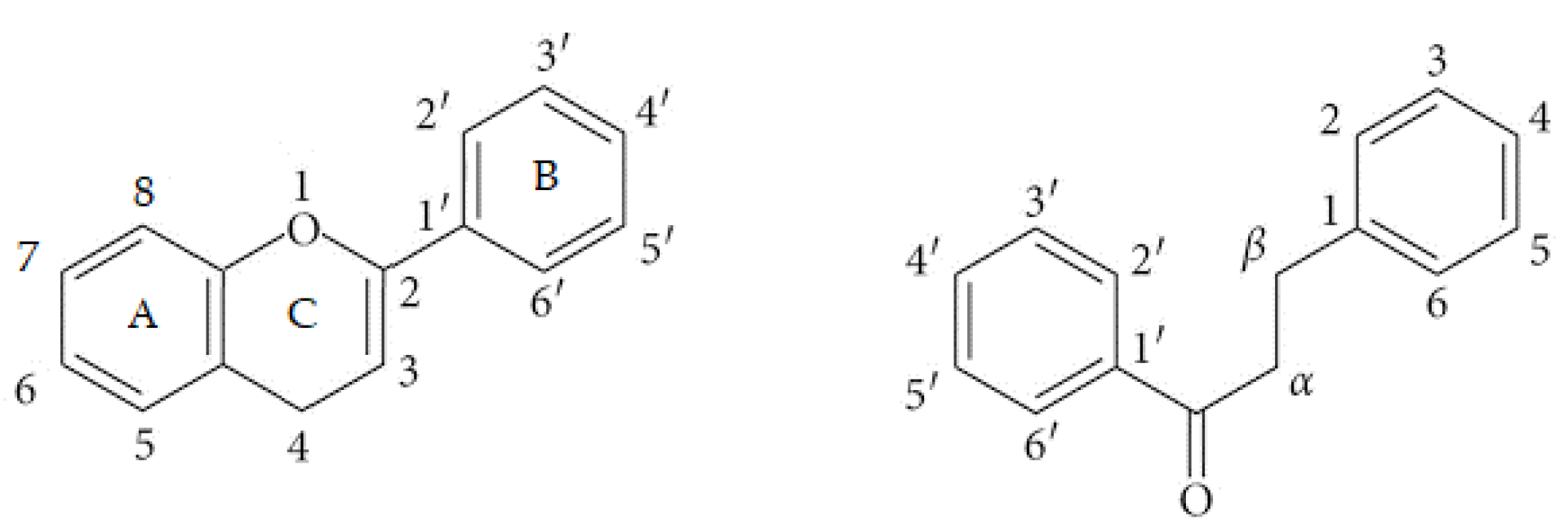
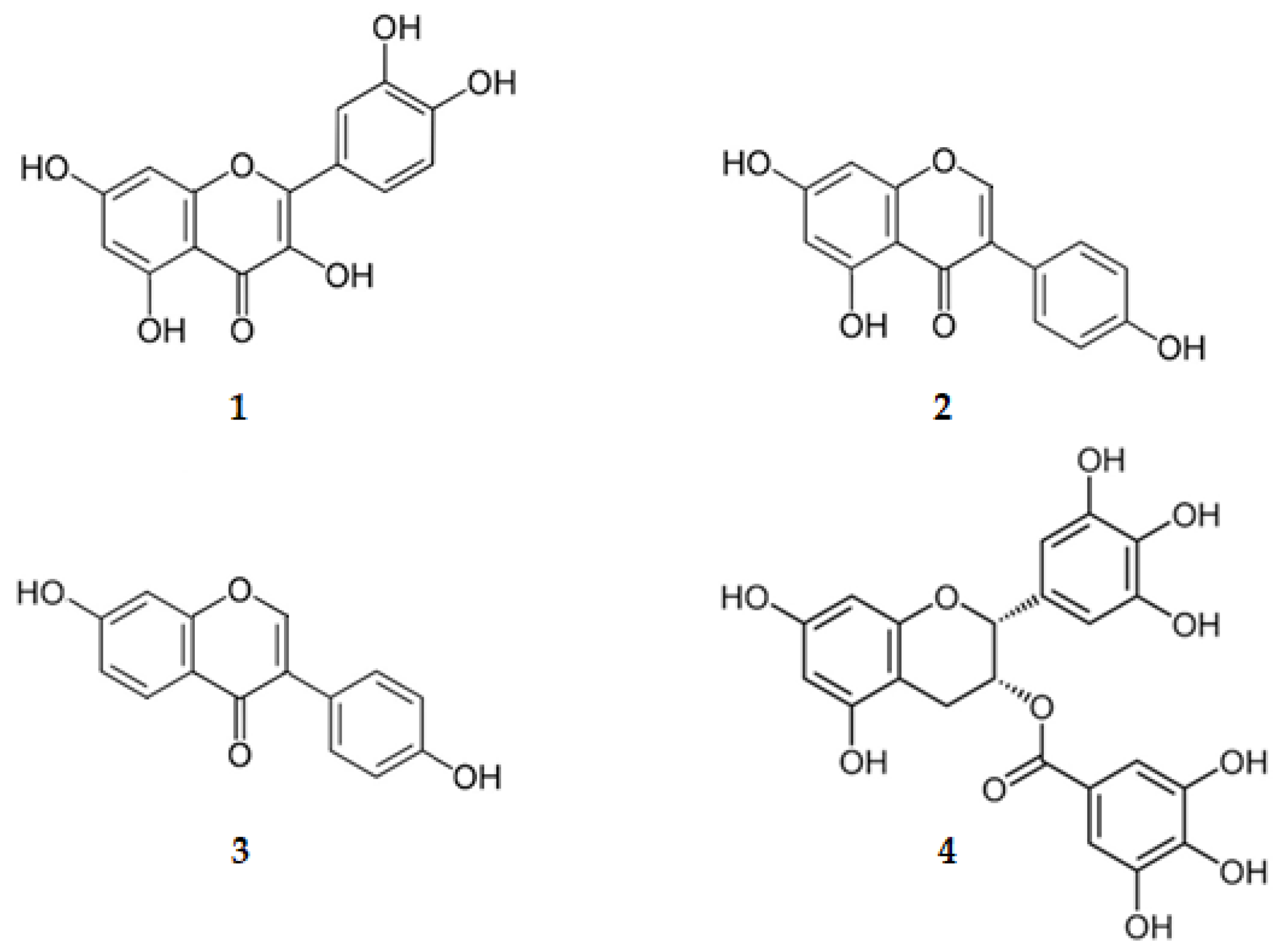
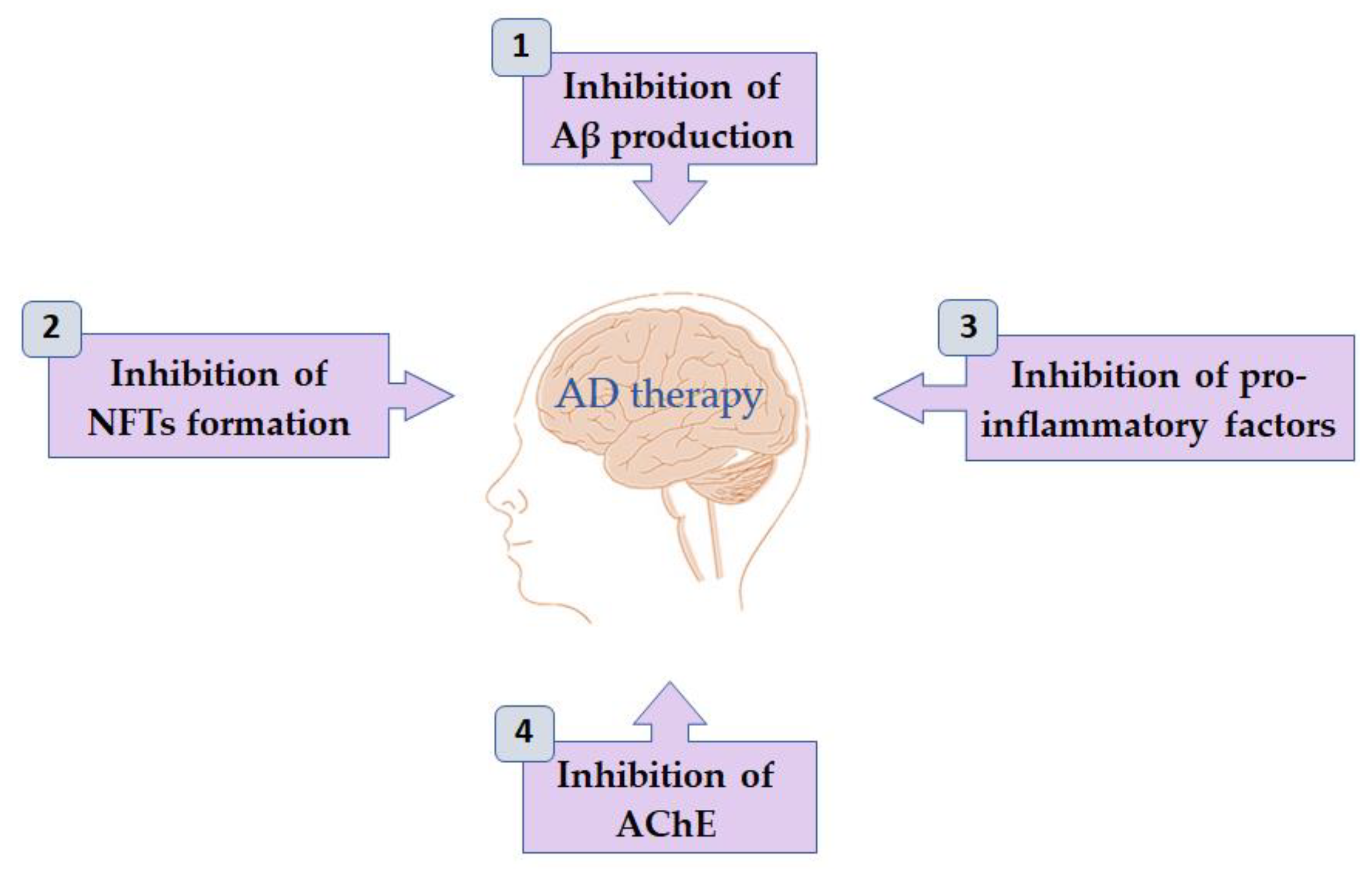
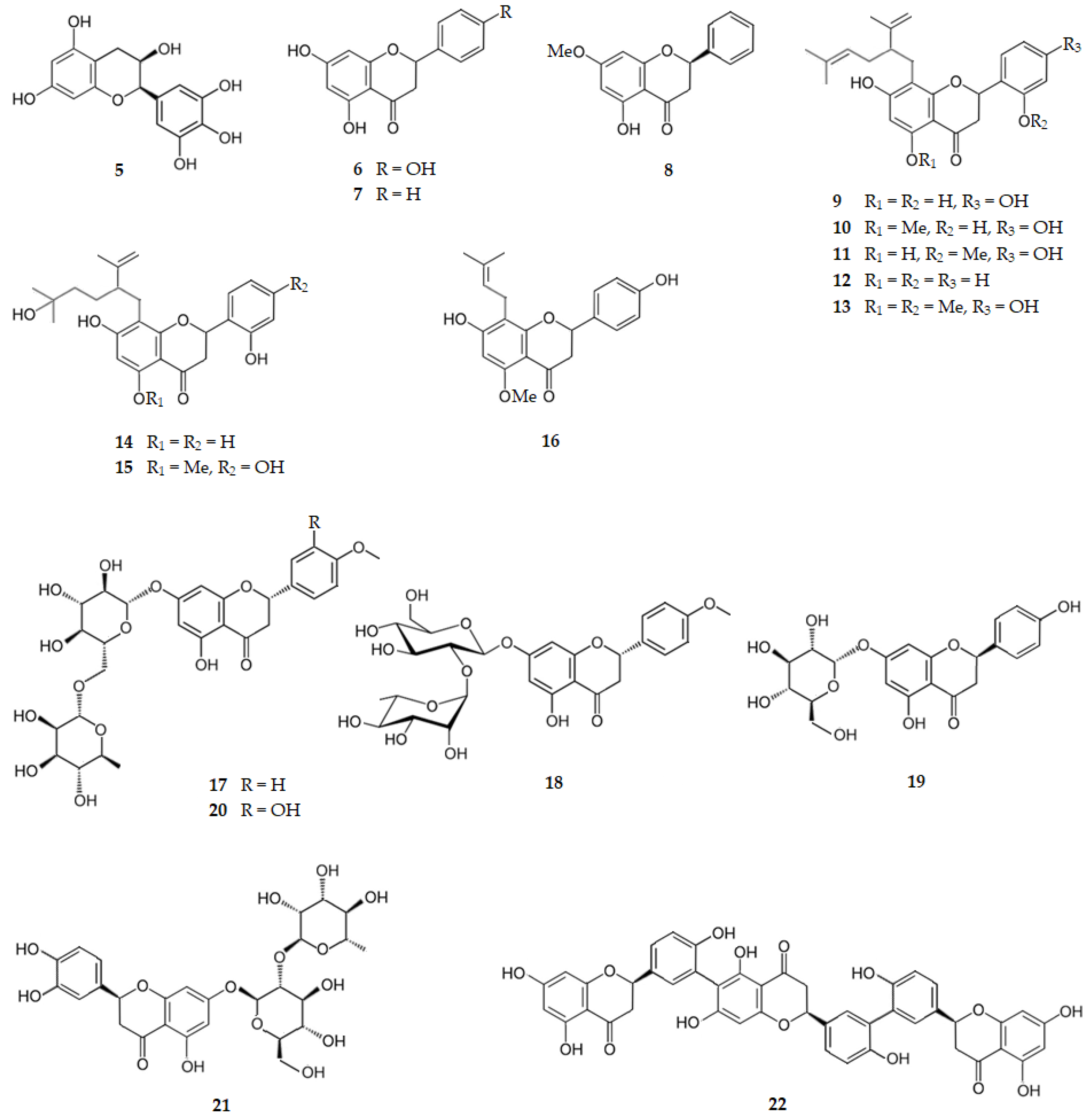

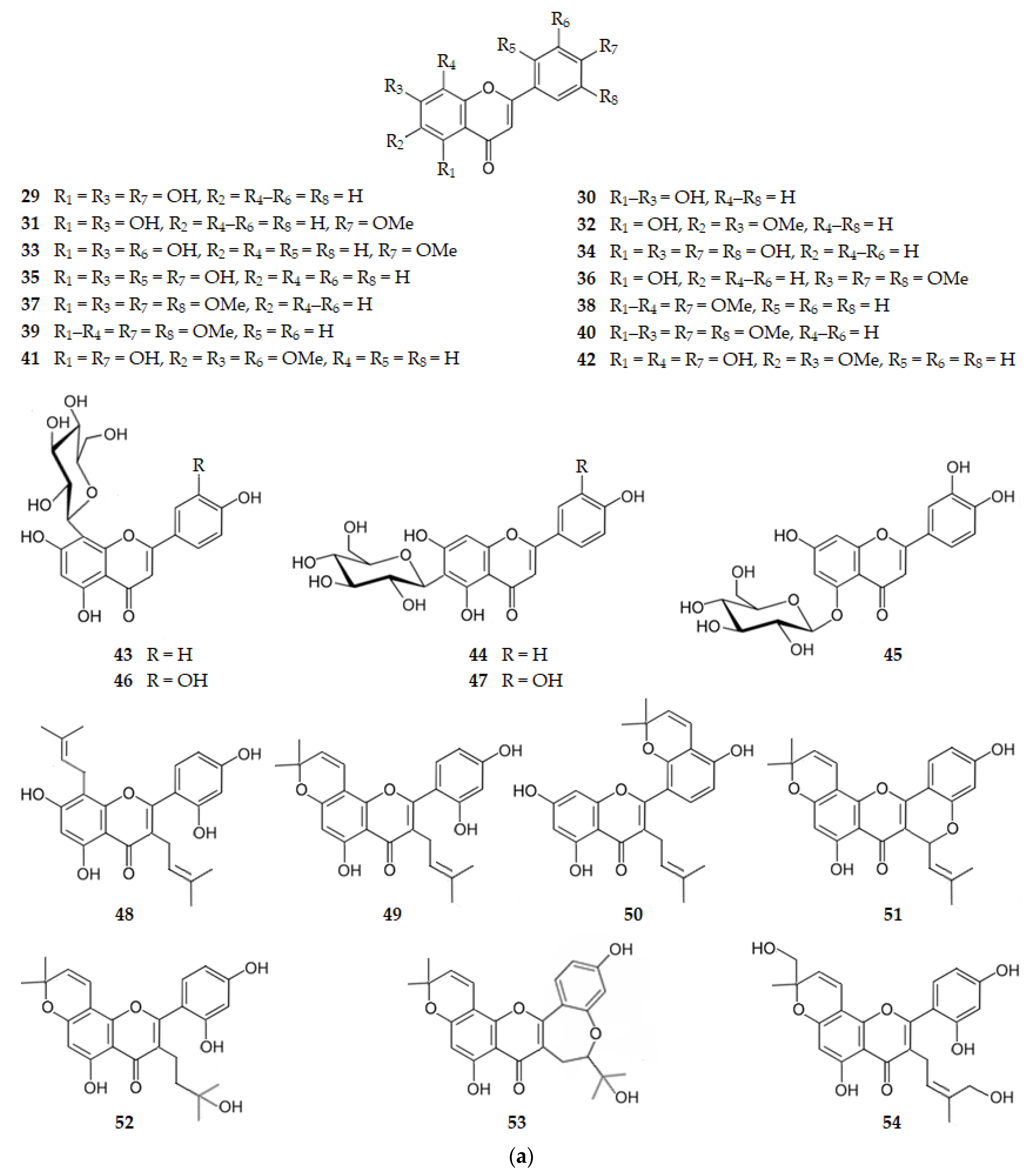
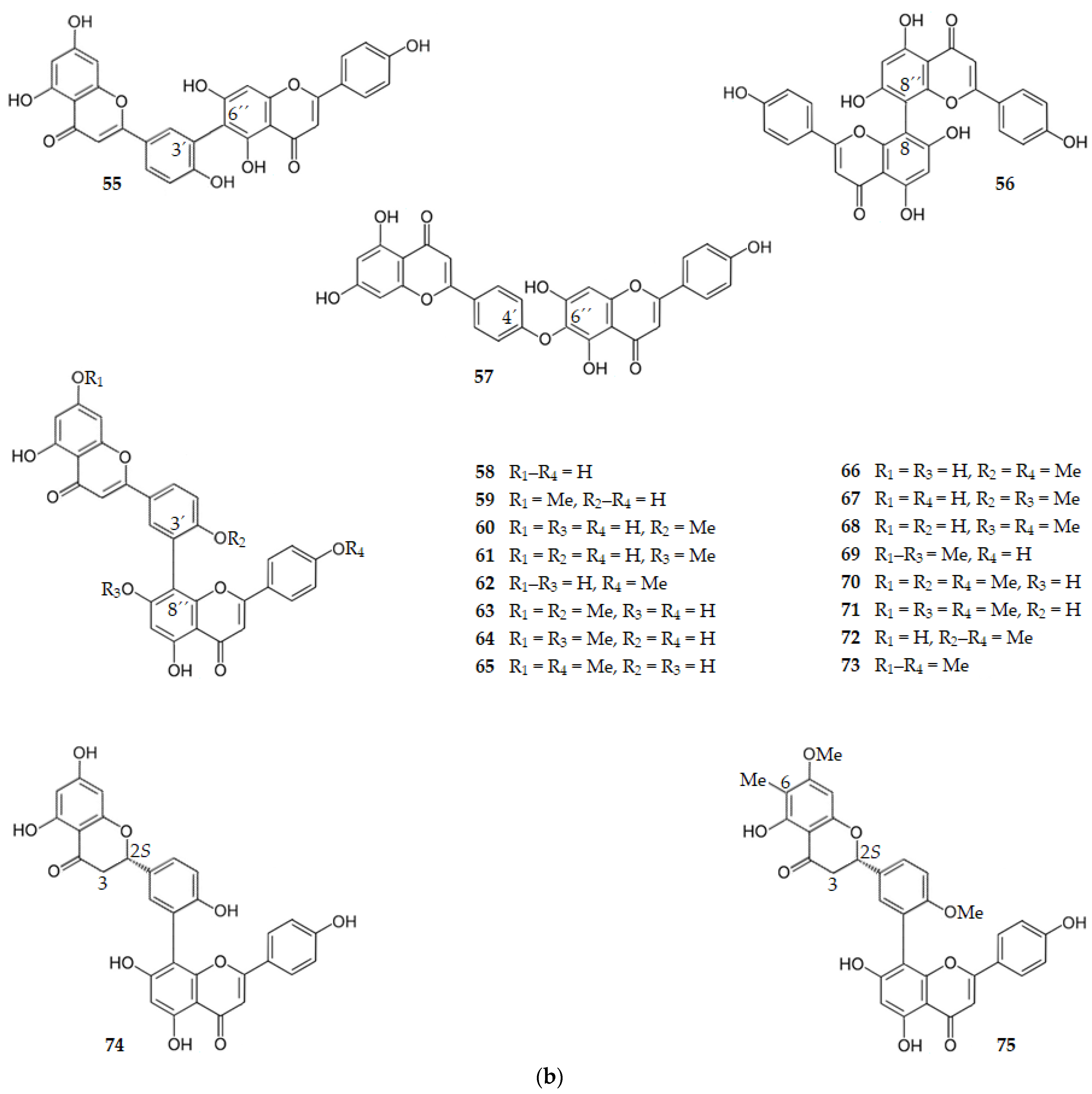

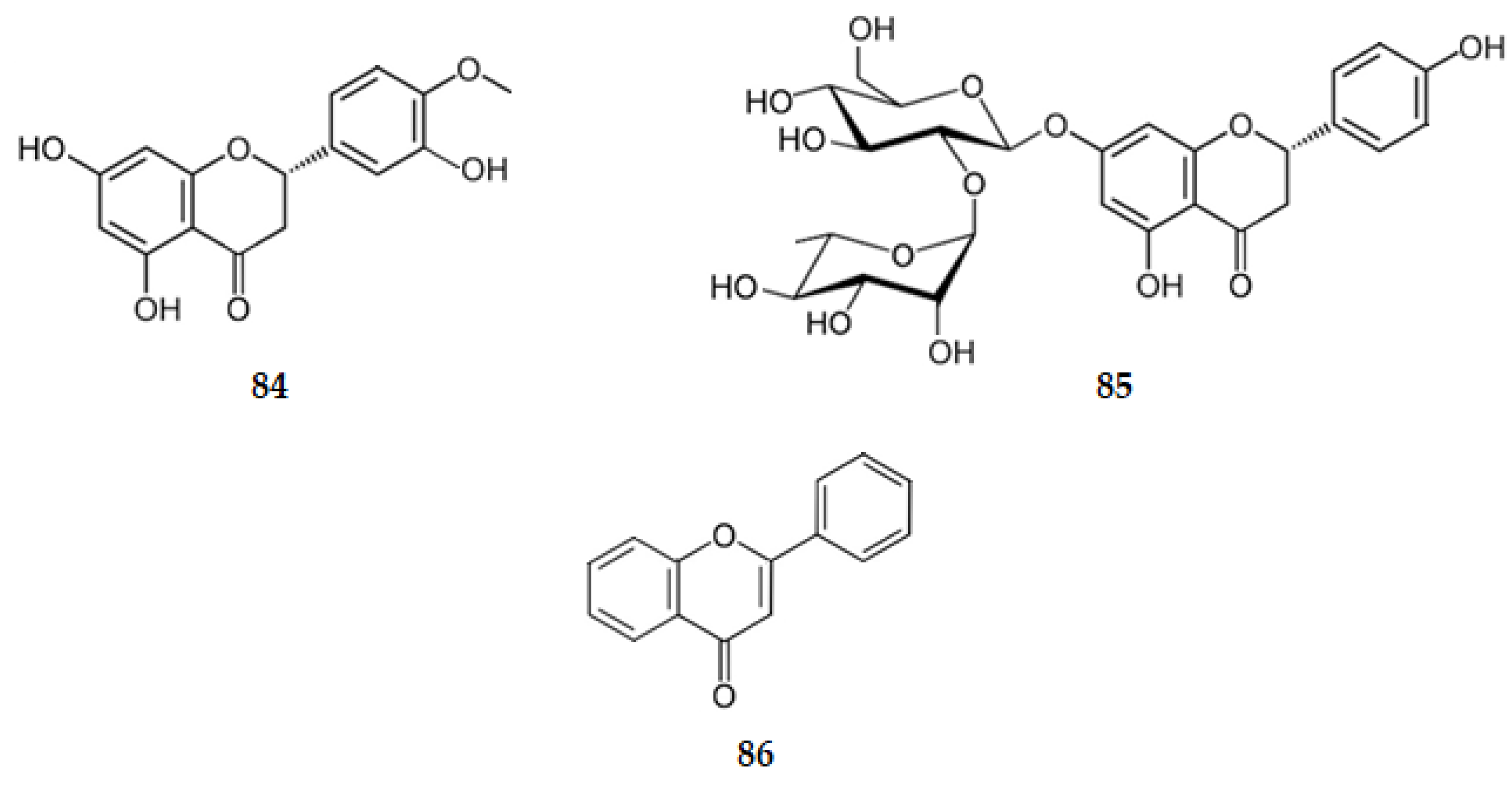
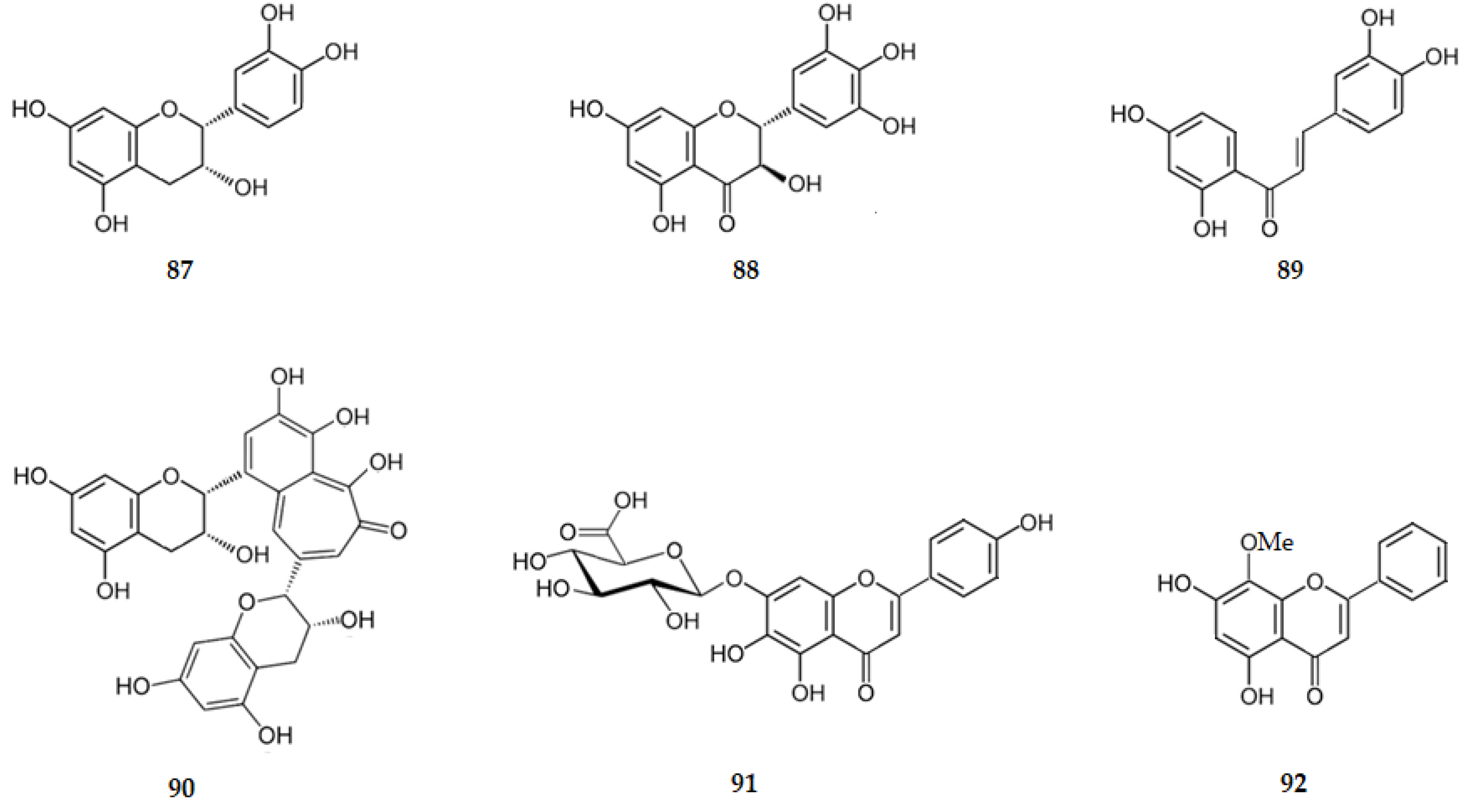
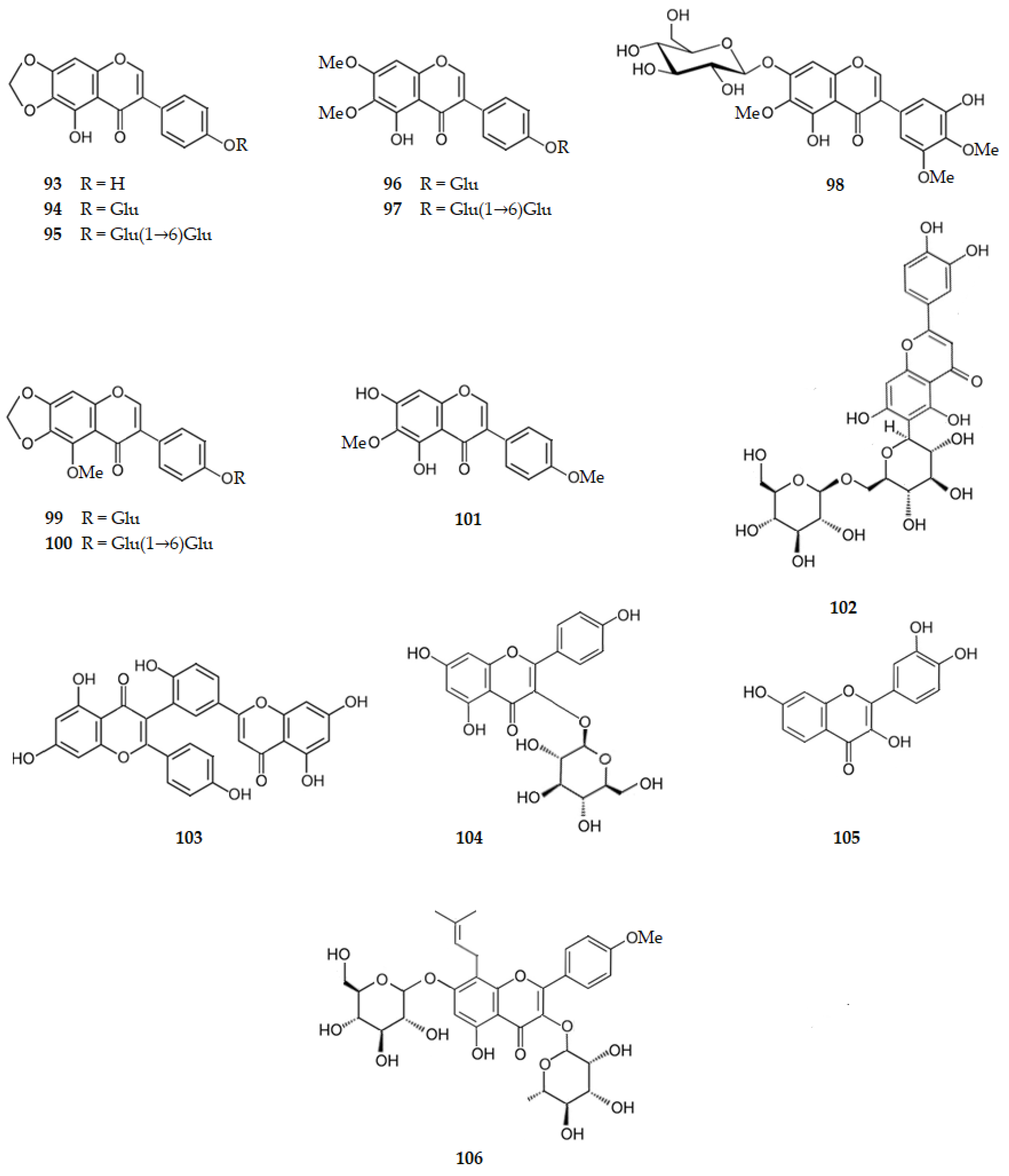


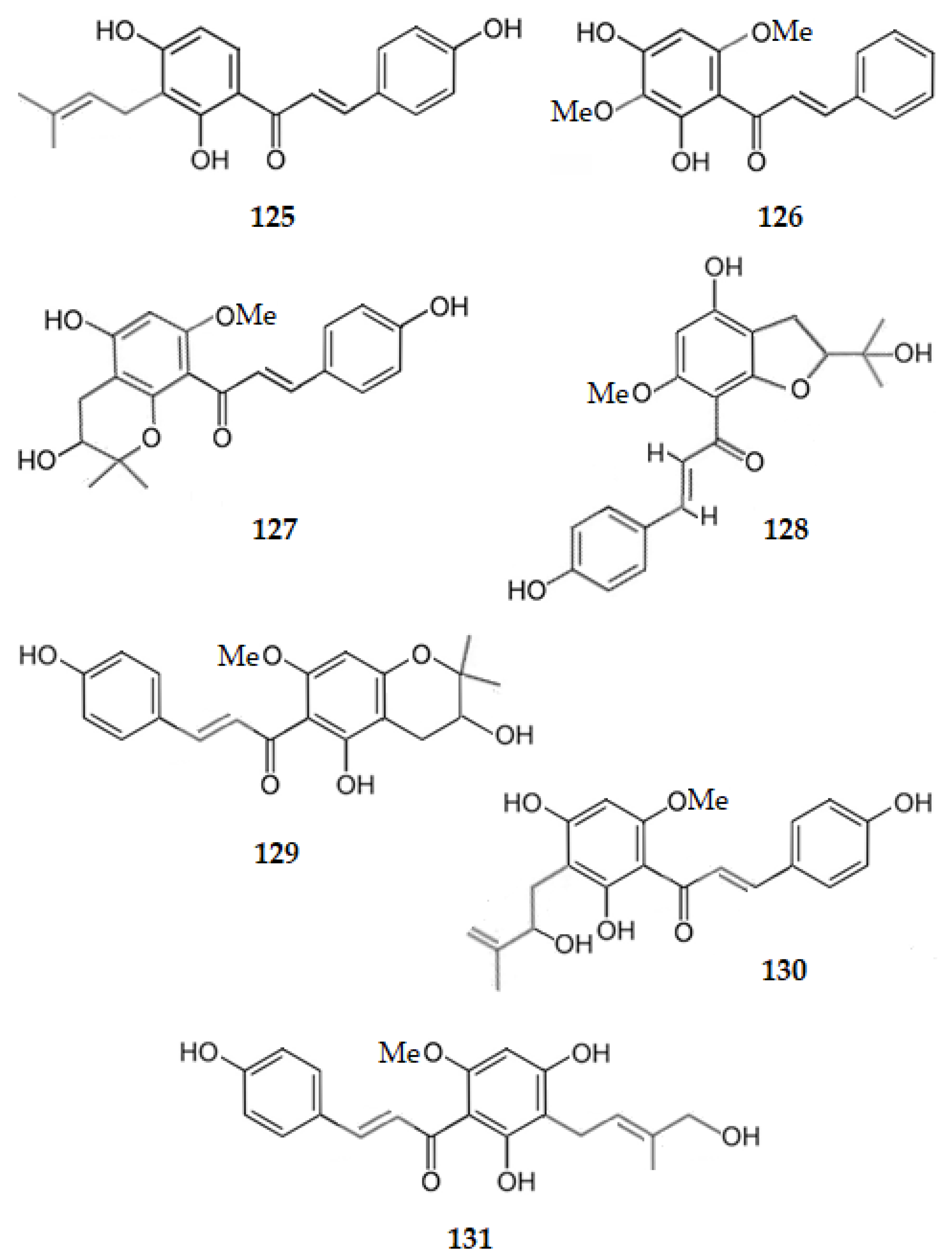
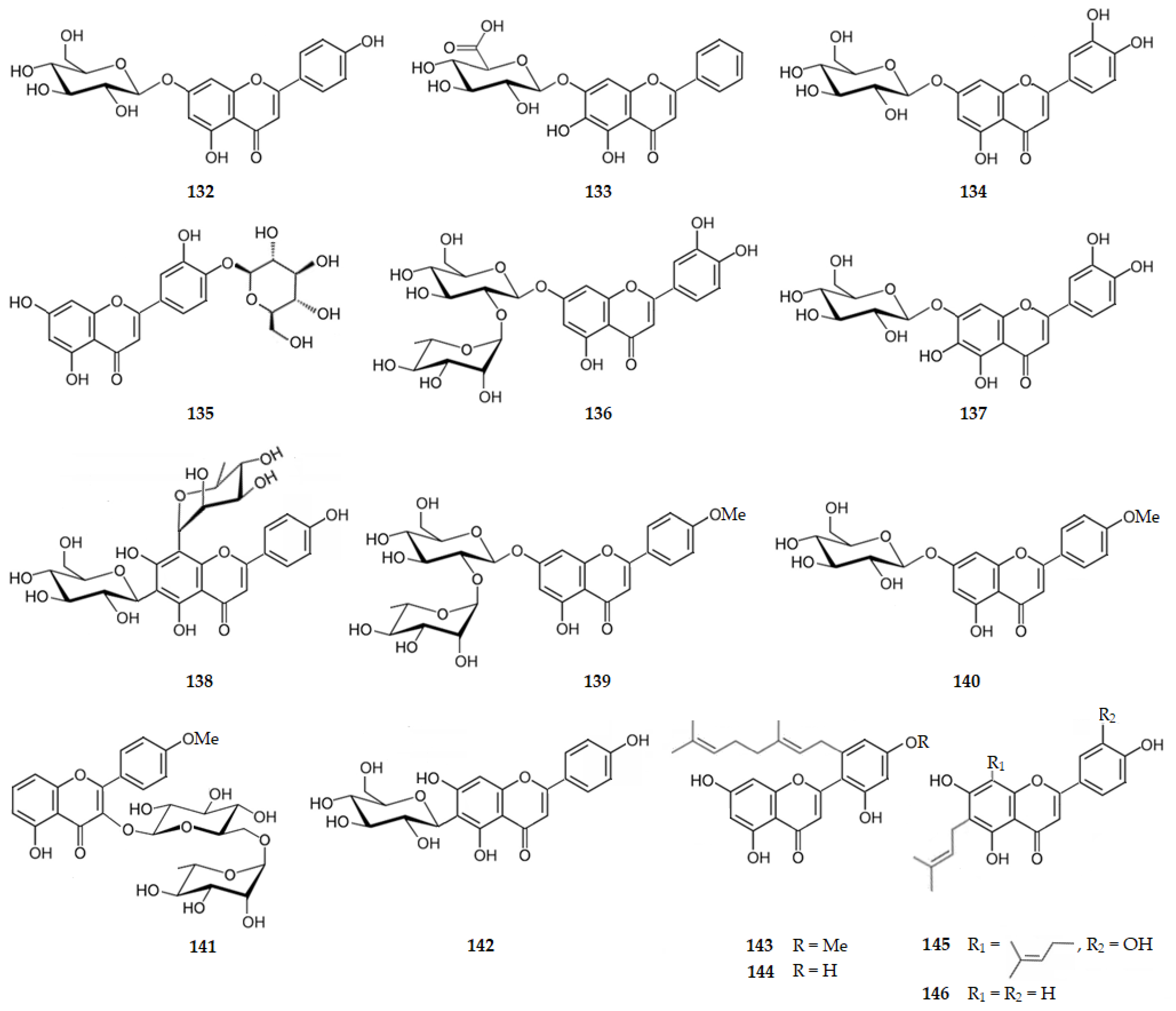
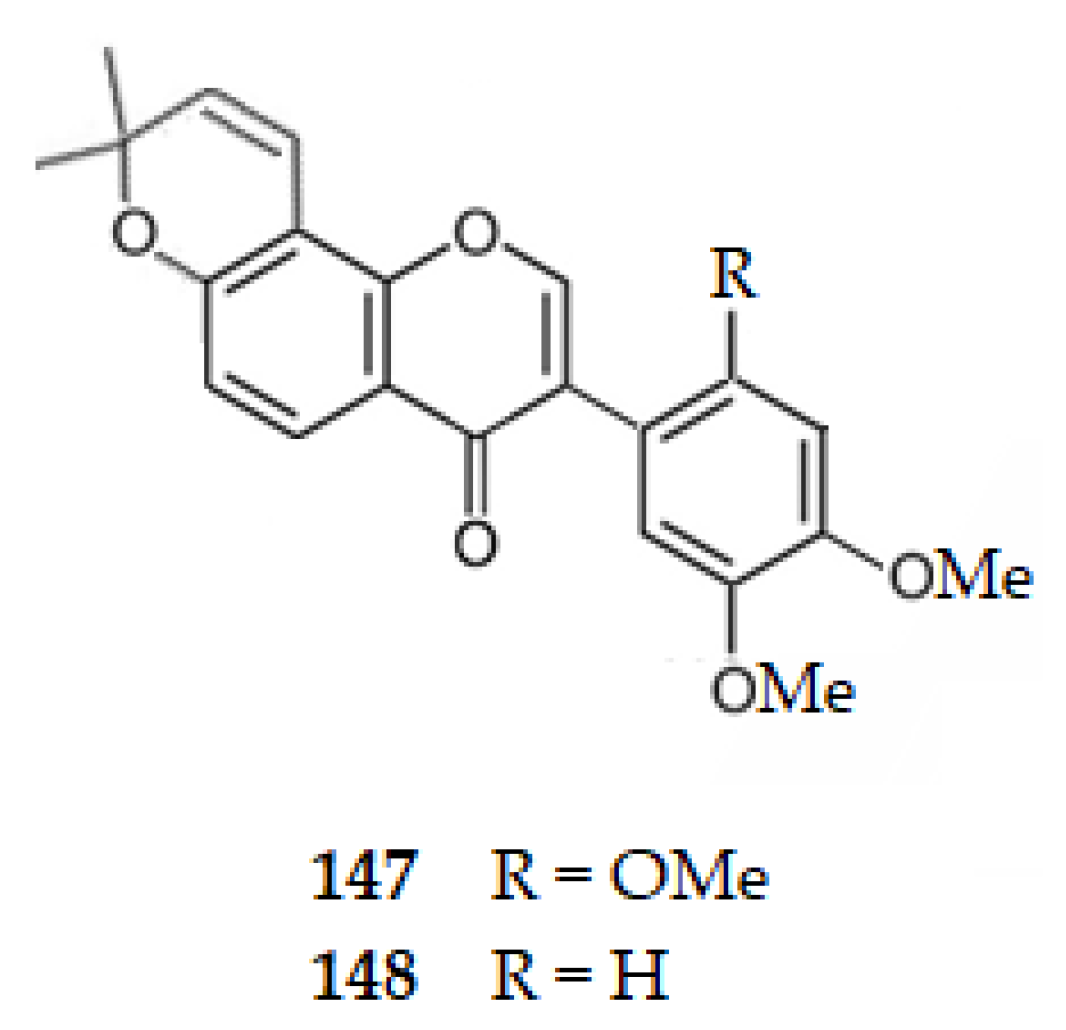

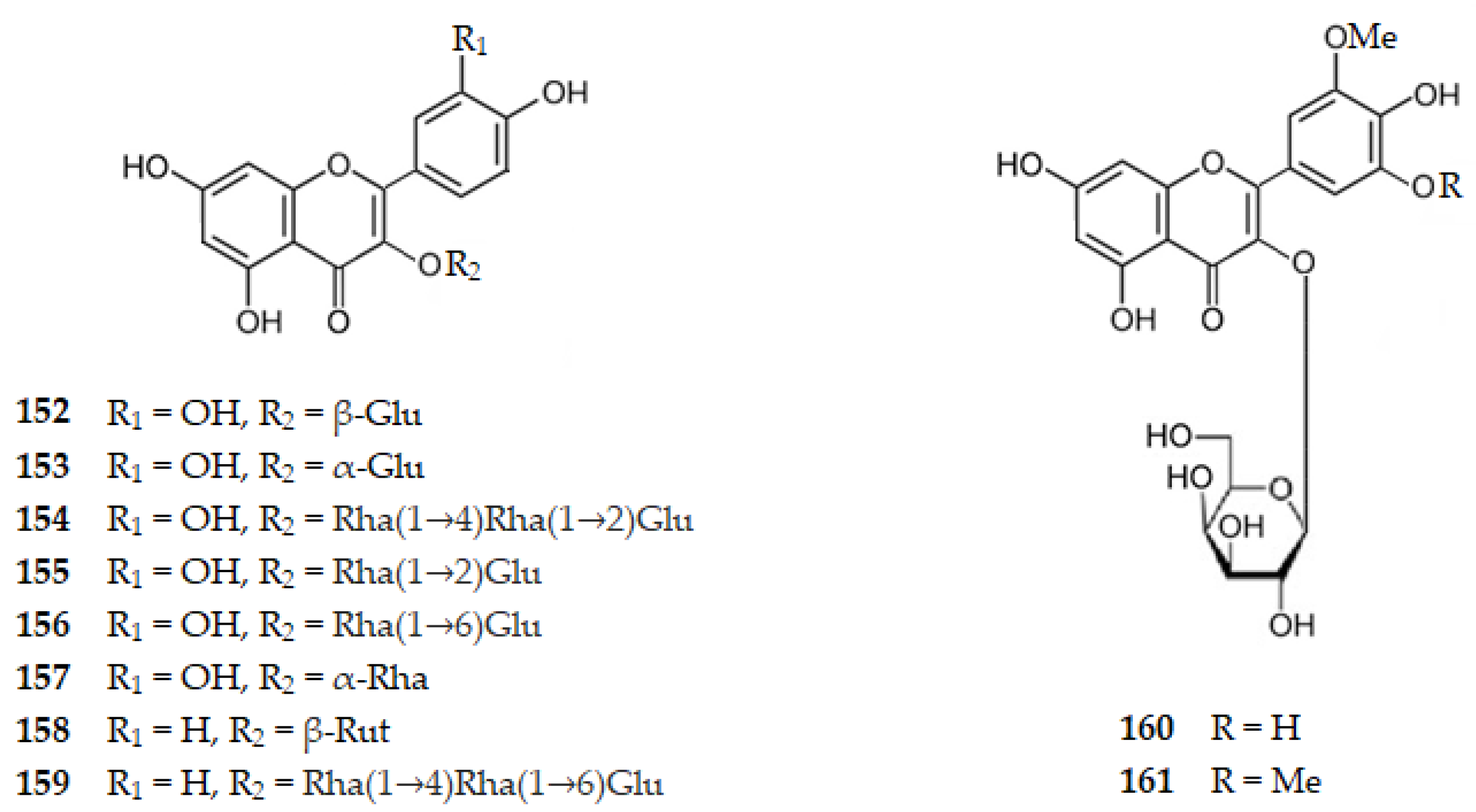
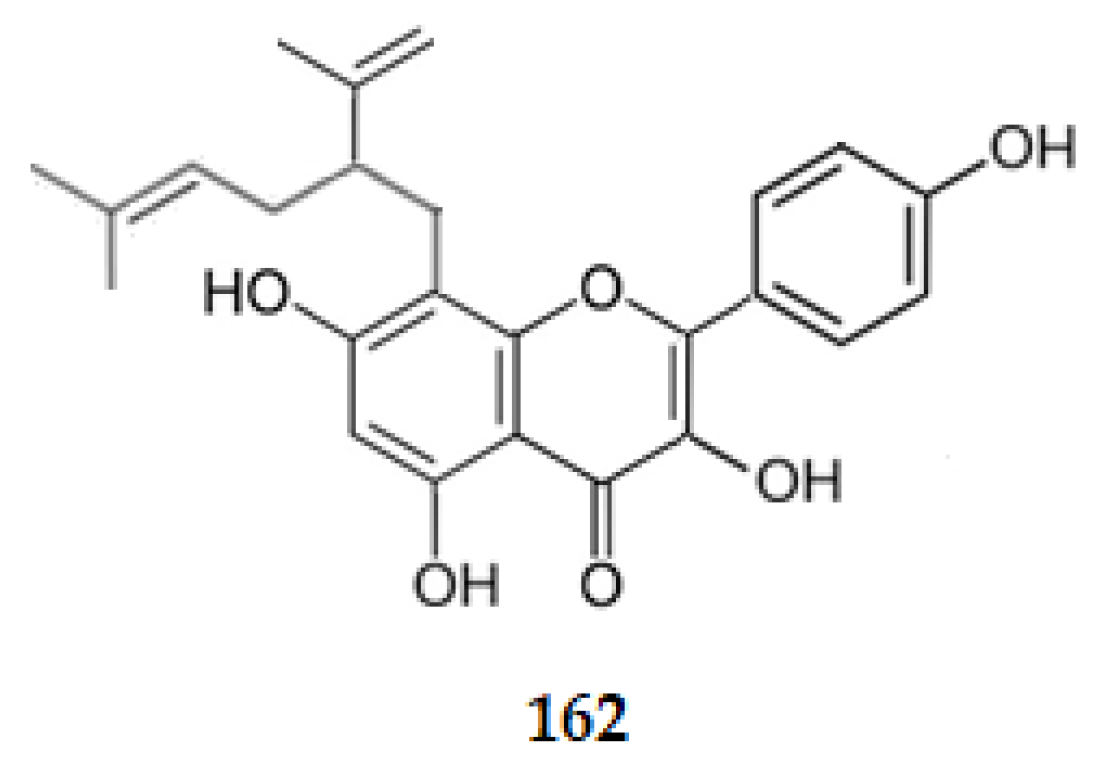
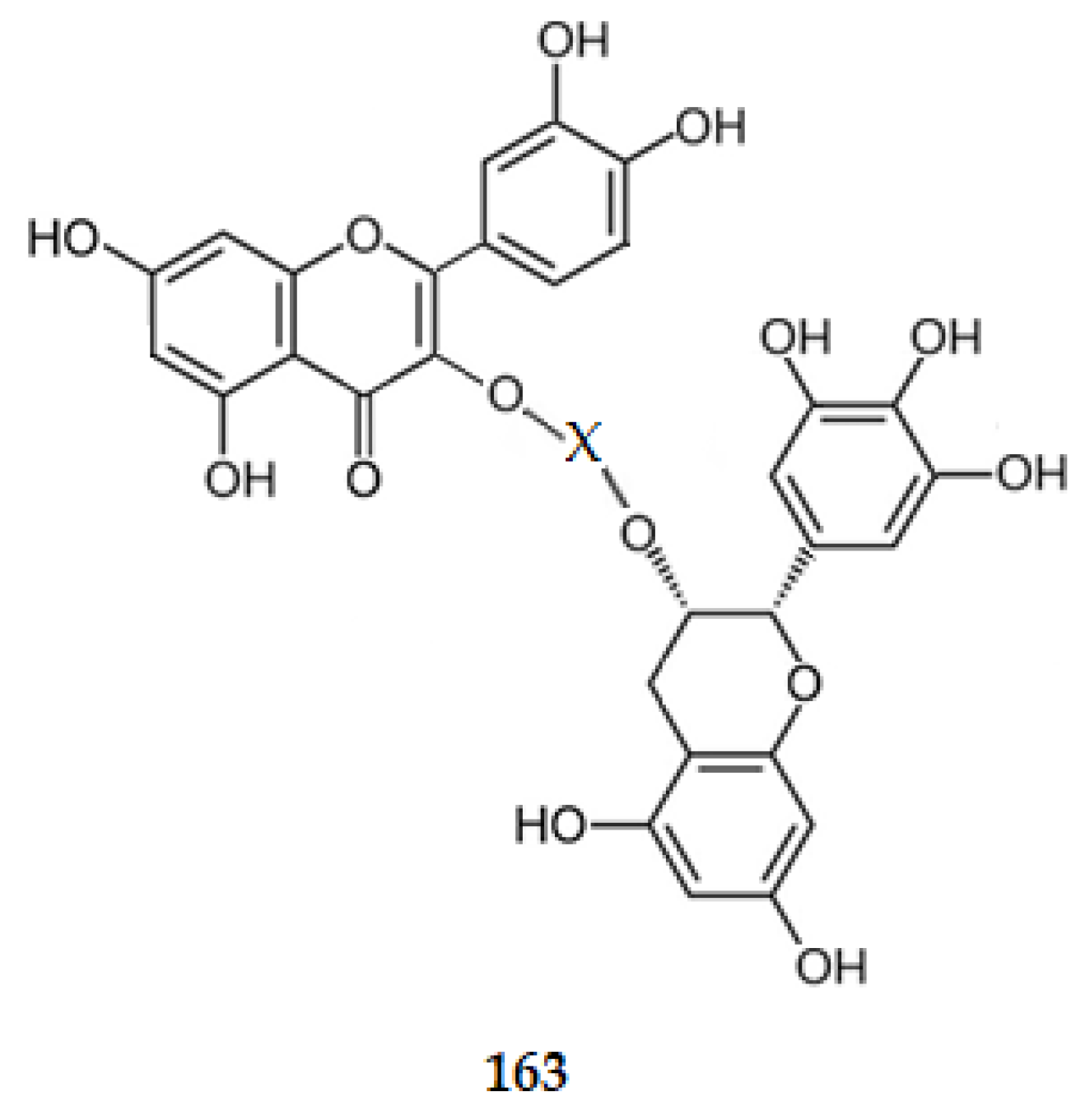
| Flavonoid | Description | Dosage (mg/d) | Status (Phase) | Clinical Trial (Gov. Identifier) |
|---|---|---|---|---|
| Quercetin | Pilot study for evaluation of the penetration of the combination with Dasatinib in elderly early AD patients | - | 2 | NCT04063124 |
| Quercetin | Interventional-open label study to evaluate the safety and feasibility of the combination with Dasatinib in AD and mild cognitive impairment patients | 1000 | 2 | NCT04785300 |
| Quercetin | Interventional study to evaluate the efficacy, safety and feasibility of the combination with Dasatinib in older patients with early stage of AD | 1000 | 2 | NCT04685590 |
| Genistein | To check the effect of 60 mg BID genistein in patients suffering AD | R | NCT01982578 | |
| Daidzein/Genistein | Pilot study of capsules mixing Diadzein and Genistein (Novasoy) for observing the improvement in cognitive function of patients suffering AD | 100 | 2 | NCT00205179 |
| EGCG | Randomized and double blinded study to evaluate the effectiveness of EGCG along with dietary, physical and cognitive intervention in AD patients | - | R | NCT03978052 |
| Flavonoid | Mechanism of Action | IC50 (μM) | Ref. | |||
|---|---|---|---|---|---|---|
| N. | Name | LogP 1 | Class | |||
| 1 | Quercetin | 1.48 | Flavonol | BACE1 | 5.40 | [50,51,52] |
| GSK-3β | 2.00 | [52] | ||||
| P-IF | NE | [47,53,54] | ||||
| AChE | 19.80 | [55,56] | ||||
| 2 | Genistein | 2.84 | Isoflavone | P-IF | NE | [47] |
| AChE | 167.00 | [57] | ||||
| 3 | Daidzein | 2.63 | Isoflavone | P-IF | NE | [47] |
| 4 | (−)-EGCG | 0.64 | Flavanol | P-IF | NE | [47] |
| AChE | 0.0096 | [58] | ||||
| 5 | (−)-Epigallocatechin | −0.10 | Flavanol | BACE1 | 2.40 | [50] |
| 6 | (−)-Naringenin | 2.52 | Flavanone | BACE1 | 38.06 | [59] |
| GSK-3β | 45.71 | [52] | ||||
| P-IF | NE | [47,54] | ||||
| AChE | 3.81 | [60] | ||||
| 7 | (+)-Pinocembrin | 3.09 | Flavanone | BACE1 | 27.01 | [61] |
| 8 | (+/−)-Pinostrobin | 3.10 | Flavanone | BACE1 | 4.35 | [61] |
| AChE | NA | [62] | ||||
| 9 | Sophoraflavanone G | 3.96 | Flavanone | BACE1 | 5.20 | [63] |
| P-IF | NE | [47] | ||||
| 10 | (−)-Kurarinone | - | Flavanone | BACE1 | 3.30 | [63] |
| 11 | Leachianone A | - | 8.40 | |||
| 12 | Kushenol A | - | 2.60 | |||
| 13 | (2S)-2′-Methoxykurarinone | - | 6.70 | |||
| 14 | Kushenol T | 5.85 | 36.80 | |||
| 15 | Kurarinol | 4.80 | 39.20 | |||
| 16 | Isoxanthohumol | 4.75 | Flavanone | BACE1 | 27.70 | [63] |
| AChE | NA | [64] | ||||
| 17 | Didymin | 2.72 | Flavanone | BACE1 | 2.34 | [59] |
| AChE | 2.13 | [59] | ||||
| 18 | Poncirin | - | Flavanone | BACE1 | 3.96 | [59] |
| AChE | 12.96 | [59] | ||||
| 19 | (−)-Prunin | 0.60 | Flavanone | BACE1 | 13.41 | [59] |
| AChE | 6.31 | [59] | ||||
| 20 | (−)-Hesperidin | - | Flavanone | BACE1 | 10.02 | [65] |
| GSK-3β | NA | [66] | ||||
| P-IF | NE | [47] | ||||
| AChE | 22.80 | [66] | ||||
| 21 | Neoeriocitrin | - | Flavanone | BACE1 | 22.49 | [60] |
| 22 | Selagintriflavonoid A | - | 0.75 | [67] | ||
| 23 | Cardamonin | 3.55 | Chalcone | BACE1 | 4.35 | [61] |
| 24 | 2,2′,4-Trihydroxychalcone | 2.99 | 2.50 | [51] | ||
| 25 | Xanthohumol | 5.43 | Chalcone | BACE1 | 7.19 | [68] |
| AChE | 71.34 | [64] | ||||
| 26 | Kuraridin | - | Chalcone | BACE1 | 6.03 | [68] |
| 27 | Kuraridinol | 5.83 | 7.10 | |||
| 28 | Phlorizin | 0.72 | Dihydrochalcone | BACE1 | 2.70 | [69] |
| 29 | Apigenin | 3.02 | Flavone | BACE1 | 38.50 | [49,50,52,53] |
| GSK-3β | 1.91 | [66] | ||||
| P-IF | NE | [47] | ||||
| AChE | 34.43 | [49] | ||||
| 30 | Baicalein | 3.27 | Flavone | BACE1 | 69.18 | [70] |
| AChE | 0.61 | [55] | ||||
| P-IF (NO) | 66.40 | [54,71] | ||||
| 31 | Acacetin | 3.41 | Flavone | BACE1 | 88.50 | [72] |
| AChE | 50.33 | [73] | ||||
| 32 | Mosloflavone | 3.19 | Flavone | BACE1 | 43.65 | [70] |
| 33 | Diosmetin | 3.10 | Flavone | BACE1 | 43.65 | [70] |
| P-IF | NE | [47] | ||||
| 34 | Luteolin | 2.53 | Flavone | BACE1 | 13.75 | [74] |
| GSK-3β | 1.51 | [66] | ||||
| P-IF (NO) | 1.74 | [47,54,75,76] | ||||
| AChE | 9.27 | [76] | ||||
| 35 | Norartocarpetin | 2.36 | Flavone | BACE1 | 60.60 | [52] |
| 36 | 5-Hydroxy-3′,4′,7-trimethoxyflavone | - | 2.14 | [70] | ||
| 37 | 3′,4′,5,7-Tetramethoxyflavone | 2.43 | 1.66 | [70] | ||
| 38 | Tangeritin | 3.18 | Flavone | BACE1 | 49.00 | [77] |
| GSK-3β | NA | [66] | ||||
| 39 | Nobiletin | 2.74 | Flavone | BACE1 | 59.00 | [77] |
| GSK-3β | 52.48 | [66] | ||||
| 40 | Sinensetin | 2.66 | Flavone | BACE1 | 63.00 | [77] |
| 41 | Cirsilineol | 2.54 | 20.35 | [78] | ||
| 42 | Isothymusin | 1.98 | 4.45 | [78] | ||
| 43 | Vitexin | −1.68 | Flavone | BACE1 | 51.07 | [79] |
| AChE | 12.16 | [79] | ||||
| 44 | Isovitexin | 0.32 | Flavone | BACE1 | NA | [79] |
| GSK-3β | 195.00 | [80] | ||||
| P-IF (NO) | 66.70 | [81] | ||||
| AChE | 6.24 | [79] | ||||
| 45 | 5-O-(β-d-Glucopyranosyl)luteolin | 0.10 | Flavone | BACE1 | NA | [74] |
| 46 | Orientin | −2.16 | Flavone | BACE1 | 15.95 | [76] |
| GSK-3β | NA | [80] | ||||
| AChE | 20.06 | [76] | ||||
| 47 | Isoorientin | −0.16 | Flavone | BACE1 | 20.88 | [76] |
| GSK-3β | 185.00 | [80] | ||||
| P-IF (NO) | 61.00 | [81] | ||||
| AChE | 29.48 | [76] | ||||
| 48 | Kuwanon C | 7.07 | Flavone | BACE1 | 3.40 | [52,82] |
| AChE | 25.06 | [83] | ||||
| 49 | Morusin | 4.48 | Flavone | BACE1 | 59.40 | [52,82] |
| AChE | 36.40 | [83] | ||||
| 50 | Kuwanon A | - | Flavone | BACE1 | 5.30 | [52,82] |
| 51 | Cyclomorusin | 6.74 | Flavone | BACE1 | 102.20 | [52,82] |
| AChE | 31.69 | [83] | ||||
| 52 | Morusinol | 3.47 | Flavone | BACE1 | 135.90 | [52,82] |
| AChE | 173.49 | [83] | ||||
| 53 | Neocyclomorusin | - | Flavone | BACE1 | 146.10 | [52,82] |
| AChE | 26.69 | [83] | ||||
| 54 | Mormin | - | Flavone | BACE1 | 103.50 | [52,82] |
| 55 | Robustaflavone | - | NA | [84] | ||
| 56 | Cupressuflavone | - | NA | [84] | ||
| 57 | Hinokiflavone | - | NA | [84] | ||
| 58 | Amentoflavone | 3.49 | Flavone | BACE1 | 1.54 | [84] |
| P-IF | NE | [85] | ||||
| 59 | Sequoiaflavone | - | Flavone | BACE1 | 1.40 | [84] |
| 60 | Bilobetin | - | Flavone | BACE1 | 2.02 | [84] |
| P-IF | NE | [85] | ||||
| 61 | Sotetsuflavone | - | Flavone | BACE1 | 1.58 | [84] |
| 62 | Podocarpusflavone A | - | 0.99 | |||
| 63 | Ginkgetin | 4.45 | Flavone | BACE1 | 4.18 | [84] |
| P-IF | NE | [85] | ||||
| 64 | Amentoflavone-7,7″-dimethylether | - | Flavone | BACE1 | 6.25 | [84] |
| 65 | Podocarpusflavone B | - | 4.21 | |||
| 66 | Isoginkgetin | 5.24 | 3.01 | |||
| 67 | 4′,7″-Di-O-methylamentoflavone | - | NA | |||
| 68 | 7″,4″′-Di-O-imethylamentoflavone | - | NA | |||
| 69 | 4′,7,7″-Tri-O-methylamentoflavone | - | NA | |||
| 70 | Sciadopitysin | - | NA | |||
| 71 | Heveaflavone | - | NA | |||
| 72 | Kayaflavone | 6.04 | NA | |||
| 73 | 7,7″,4′,4″′-Tetra-O-methylamentoflavone | - | NA | |||
| 74 | 2,3-Dihydroamentoflavone | - | 0.75 | |||
| 75 | 2,3-Dihydro-6-methylginkgetin | - | 0.35 | |||
| 76 | Kaempferol | 1.96 | Flavonol | BACE1 | 14.70 | [52] |
| GSK-3β | 3.47 | [66] | ||||
| P-IF | NE | [47] | ||||
| AChE | 30.40 | [86] | ||||
| 77 | Morin | 1.54 | Flavonol | BACE1 | 21.70 | [52] |
| GSK-3β | NE | [53] | ||||
| AChE | 210.00 | [87] | ||||
| 78 | Myricetin | 1.42 | Flavonol | BACE1 | 2.40 | [52] |
| AChE | 157.11 | [88] | ||||
| 79 | Sophoflavescenol | 4.10 | Flavonol | BACE1 | 10.98 | [89] |
| AChE | 8.37 | [89] | ||||
| 80 | Icaritin | 4.87 | Flavonol | BACE1 | 22.48 | [89] |
| AChE | 6.47 | [89] | ||||
| 81 | Desmethylanhydroicaritin | 4.31 | Flavonol | BACE1 | 1.51 | [89] |
| AChE | 6.67 | [89] | ||||
| 82 | Kushenol C | - | Flavonol | BACE1 | 5.45 | [68] |
| 83 | Rutin (Sophorin) | −2.02 | Flavonol | BACE1 | 0.004 | [90] |
| P-IF | NE | [47] | ||||
| AChE | 19.65 | [91] | ||||
| 84 | Hesperetin | 2.60 | Flavanone | GSK-3β | 26.92 | [66] |
| P-IF | NE | [54] | ||||
| 85 | Naringin | −0.44 | Flavanone | GSK-3β | NA | [66] |
| AChE | 26.40 | [60] | ||||
| 86 | Flavone | 3.56 | Flavone | GSK-3β | NA | [66] |
| 87 | Epicatechin | 0.49 | Flavanol | P-IF | NE | [47] |
| 88 | (+)-Ampelopsin | −0.73 | 3-Hydroxyflavanone | P-IF | NE | [92] |
| AChE | 59.47 | [93] | ||||
| 89 | Butein | 2.51 | Chalcone | P-IF (NO) | 10.90 | [47] |
| 90 | Theaflavin | 1.17 | Flavanol | P-IF | NE | [47] |
| 91 | Scutellarin | 0.26 | Flavone | P-IF | NE | [47] |
| 92 | Wogonin | 3.15 | Flavone | P-IF (NO) | 45.30 | [71,75,94] |
| AChE | <10.00 | [95] | ||||
| 93 | Irilone | 0.84 | Isoflavone | P-IF (NO) | 89.70 | [81] |
| 94 | 4′-O-(β-d-Glucopyranosyl)irilone | - | 80.10 | |||
| 95 | 4′-O-[β-d-Glucopyranosyl-(1→6)-β-d-glucopyranosyl]irilone | - | 83.60 | |||
| 96 | 4′-O-(β-d-Glucopyranosyl)-7-O-methyltectorigenin | - | 56.90 | |||
| 97 | 4′-O-[β-d-Glucopyranosyl-(1→6)-β-d-glucopyranosyl]-7-O-methyltectorigenin | - | 29.40 | |||
| 98 | Iridin | - | 67.50 | |||
| 99 | 4′-O-(β-d-Glucopyranosyl)irisolone | - | 98.30 | |||
| 100 | 4′-O-[β-d-Glucopyranosyl-(1→6)-β-d-glucopyranosyl]irisolone | - | 55.10 | |||
| 101 | Irisolidone | 3.23 | 23.60 | |||
| 102 | 6′’-O-(β-d-Glucopyranosyl)isoorientin | - | Flavone | P-IF (NO) | 71.90 | [81] |
| 103 | Taiwaniaflavone | - | Flavone | P-IF | NE | [85] |
| 104 | Astragalin | −0.44 | Flavonol | P-IF (NO) | 45.20 | [81] |
| AChE | 18.24 | [60] | ||||
| 105 | Fisetin | 1.18 | Flavonol | P-IF (NO) | 13.50 | [47] |
| 106 | Icariin | - | Flavonol | P-IF | NE | [96] |
| 107 | (+)-Catechin | 0.51 | Flavanol | AChE | NA | [97] |
| 108 | Dorspoinsetifolin | - | Flavanone | AChE | 91.07 | [98] |
| 109 | 4′-Hydroxyisolonchocarpin | - | NA | [98] | ||
| 110 | Nimphaeol A (Diplacone) | 6.78 | 7.77 | [99] | ||
| 111 | Nimphaeol B | - | 15.09 | [99] | ||
| 112 | Nimphaeol C | - | 15.70 | [99] | ||
| 113 | Isonimphaeol B | - | 7.23 | [99] | ||
| 114 | 3′-Geranylnaringenin | - | 12.34 | [99] | ||
| 115 | 4′-O-Methyldiplacone | - | 92.40 | [100] | ||
| 116 | 3′-O-Methyldiplacone | - | 109.20 | [100] | ||
| 117 | 6-Geranyl-3′,5,5′,7-tetrahydroxy-4′-methoxyflavan-4-one | - | 22.90 | [100] | ||
| 118 | Mimulone | 7.26 | 91.50 | [100] | ||
| 119 | 6-Geranyl-4′,5,7-trihydroxy-3′,5′-dimethoxyflavan-4-one | - | 316.30 | [100] | ||
| 120 | (−)-8-Prenylnaringenin | 4.97 | NA | [64] | ||
| 121 | 6-Prenylnaringenin | - | NA | [64] | ||
| 122 | 4′-O-Methyldiplacol | - | 3-Hydroxyflavanone | AChE | 31.90 | [100] |
| 123 | 3′-O-Methyldiplacol | - | 48.50 | |||
| 124 | 6-Geranyl-3,3′,5,5′,7-pentaahydroxy-4′-methoxyflavan-4-one | - | 15.60 | |||
| 125 | Isobavachalcone | 5.35 | Chalcone | AChE | 18.34 | [62] |
| 126 | 2′,4′-Dihydroxy-3′,6′-dimethoxychalcone | 3.38 | 20.15 | [62] | ||
| 127 | Xanthohumol L | - | NA | [64] | ||
| 128 | Xanthohumol I | - | NA | [64] | ||
| 129 | Xanthohumol B | 3.89 | NA | [64] | ||
| 130 | Xanthohumol D | 3.97 | NA | [64] | ||
| 131 | 3-Hydroxyxanthohumol | - | 51.25 | [64] | ||
| 132 | 7-O-(β-d-Glucopyranosyl)apigenin | - | Flavone | AChE | 237.74 | [101] |
| 133 | Baicalin | 0.74 | 204.10 | [102] | ||
| 134 | Cynaroside | 0.35 | 17.13 | [60] | ||
| 135 | 4′-O-(β-d-Glucopyranosyl)luteolin | 0.10 | 147.41 | [101] | ||
| 136 | Veronicastroside | - | NA | [103] | ||
| 137 | 6-Hydroxy-7-O-(β-d-glucopyranosyl)luteolin | −0.38 | 1.65 | [55] | ||
| 138 | Violanthin | - | 79.80 | [93] | ||
| 139 | 7-O-(β-Rhamnosyl)acacetin | - | NA | [104] | ||
| 140 | 7-O-(β-d-Glucopyranosyl)acacetin | 1.40 | NA | [104] | ||
| 141 | 3-O-[α-l-Rhamnopyranosyl-(1→6)-β-d-glucopyranosyl]acacetin | - | 165.04 | [105] | ||
| 142 | Swertisin | 0.88 | 71.89 | [106] | ||
| 143 | 5′-Geranyl-4′-methoxy-2′,5,7-trihydroxyflavone | - | 10.95 | [83] | ||
| 144 | 5′-Geranyl-2′,4′,5,7-tetrahydroxyflavone | - | 16.21 | [83] | ||
| 145 | 6,8-Diprenyleriodictyol | - | 15.03 | [62] | ||
| 146 | 6-Prenylapigenin | 5.20 | 25.73 | [62] | ||
| 147 | Barbigerone | 4.90 | Isoflavone | AChE | 121.60 | [98] |
| 148 | 4′,5′-Dimethoxy-6″,6″-dimethyl-6″H-pyrano-[2″,3″:7,8]isoflavone | - | 131.17 | |||
| 149 | 3-O-Methylquercetin | - | Flavonol | AChE | 37.90 | [55,56] |
| 150 | Galangin | 2.44 | 19.10 | [107] | ||
| 151 | Tamarixetin | - | 22.30 | [86] | ||
| 152 | 3-O-(β-d-Glucopyranosyl)quercetin | - | 124.73 | [105] | ||
| 153 | 3-O-(α-d-Glucopyranosyl)quercetin | - | 171.34 | [105] | ||
| 154 | 3-O-[α-l-Rhamnopyranosyl-(1→4)-α-l-rhamnopyranosyl-(1→2)-β-d-glucopyranosyl]quercetin | - | 148.81 | [105] | ||
| 155 | 3-O-[α-l-Rhamnopyranosyl-(1→2)-β-d-glucopyranosyl]quercetin | - | 126.95 | [105] | ||
| 156 | 3-O-[α-l-Rhamnopyranosyl-(1→6)-β-d-glucopyranosyl]quercetin | - | 119.74 | [105] | ||
| 157 | Quercitrin | 0.43 | 66.90 | [55,56] | ||
| 158 | Nicotiflorin | - | 15.03 | [91] | ||
| 150 | 3-O-[α-l-Rhamnopyranosyl-(1→4)-α-l-rhamnopyranosyl-(1→6)-β-d-glucopyranosyl]Kaempferol | - | 137.30 | [105] | ||
| 160 | 3-O-(β-d-Galactopyranosyl)-3′-O-methylmyricetin | - | 19.90 | [86] | ||
| 161 | 3-O-(β-d-Galactopyranosyl)-3′,5′-di-O-methylmyricetin | - | 37.80 | [86] | ||
| 162 | 8-Lavandulylkaempferol | - | 5.16 | [89] |
Disclaimer/Publisher’s Note: The statements, opinions and data contained in all publications are solely those of the individual author(s) and contributor(s) and not of MDPI and/or the editor(s). MDPI and/or the editor(s) disclaim responsibility for any injury to people or property resulting from any ideas, methods, instructions or products referred to in the content. |
© 2023 by the authors. Licensee MDPI, Basel, Switzerland. This article is an open access article distributed under the terms and conditions of the Creative Commons Attribution (CC BY) license (https://creativecommons.org/licenses/by/4.0/).
Share and Cite
Lima, E.; Rauter, A.P.; Medeiros, J. Flavonoids as Promising Multitarget Agents in Alzheimer’s Disease Therapy. Appl. Sci. 2023, 13, 4651. https://doi.org/10.3390/app13084651
Lima E, Rauter AP, Medeiros J. Flavonoids as Promising Multitarget Agents in Alzheimer’s Disease Therapy. Applied Sciences. 2023; 13(8):4651. https://doi.org/10.3390/app13084651
Chicago/Turabian StyleLima, Elisabete, Amélia P. Rauter, and Jorge Medeiros. 2023. "Flavonoids as Promising Multitarget Agents in Alzheimer’s Disease Therapy" Applied Sciences 13, no. 8: 4651. https://doi.org/10.3390/app13084651





